WOMEN IN LEADERSHIP
Mmakgoshi Lekhethe CEO, IDC TRAILBLAZER
Prof Deresh Ramjugernath Vice-Chancellor, Stellenbosch


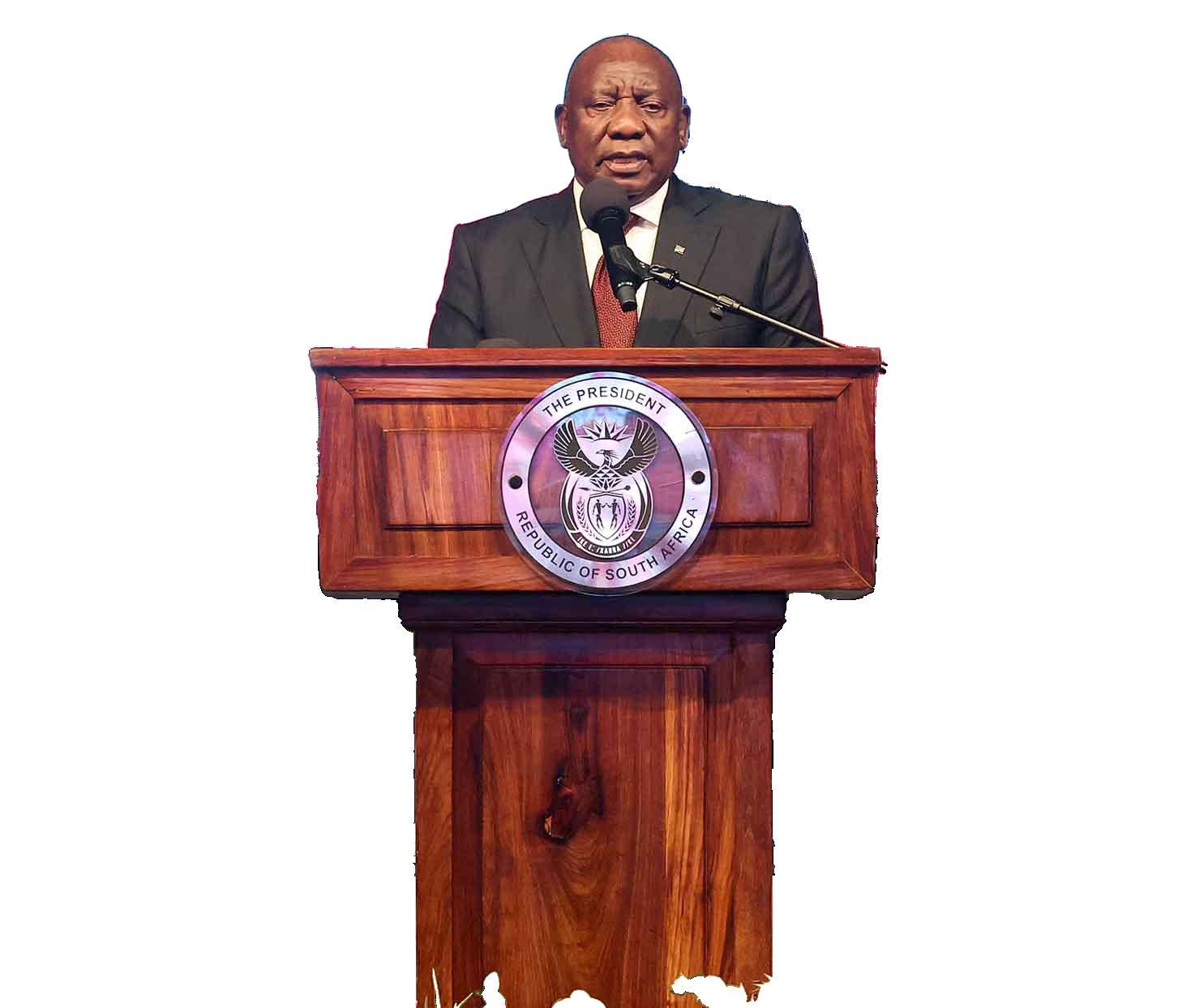

Hon. Solly Malatsi, gives his Ministral Address at Topco Media’s annual Sentech Africa Tech Week 2025

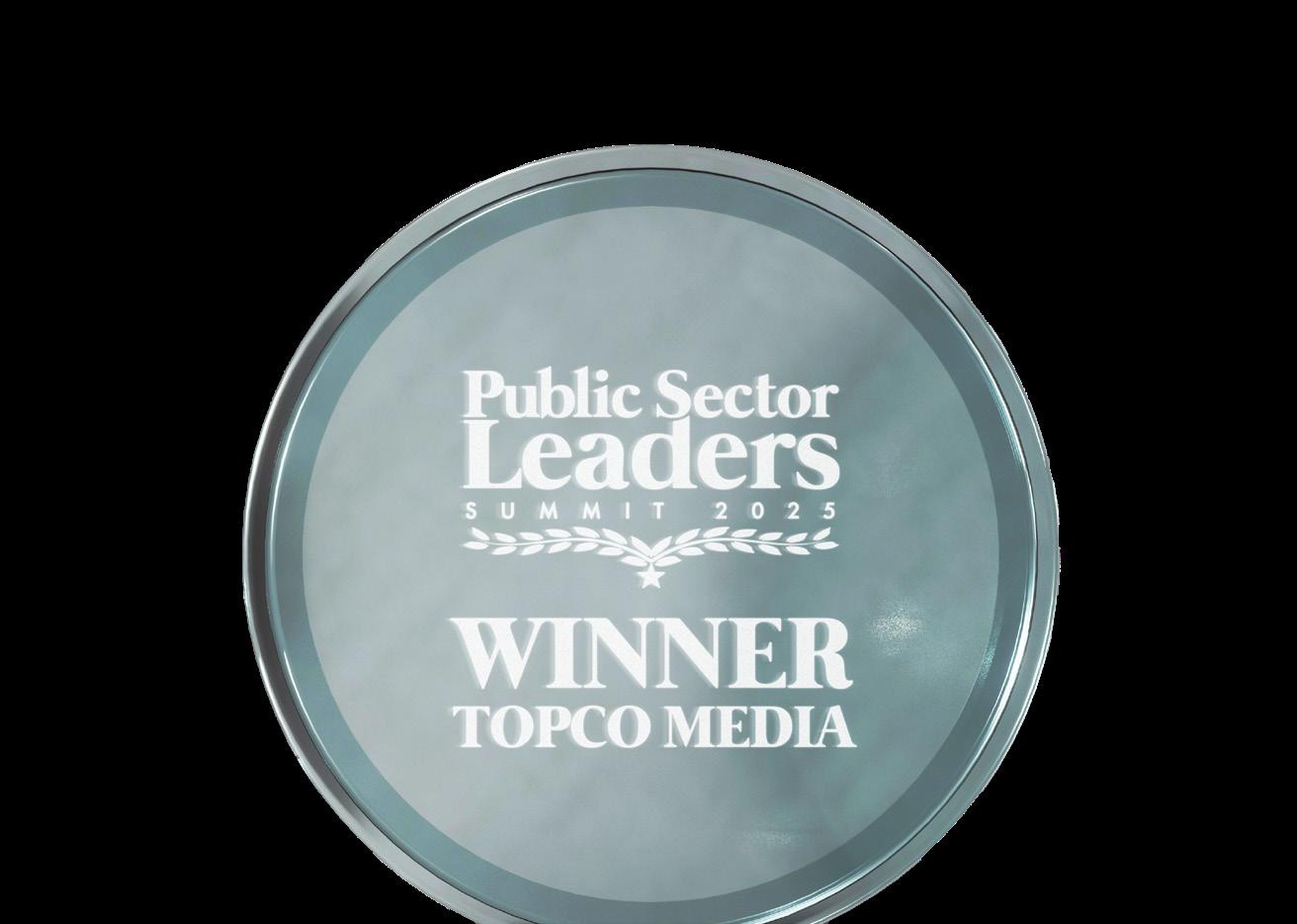




Mmakgoshi Lekhethe CEO, IDC TRAILBLAZER
Prof Deresh Ramjugernath Vice-Chancellor, Stellenbosch




Hon. Solly Malatsi, gives his Ministral Address at Topco Media’s annual Sentech Africa Tech Week 2025







The Public Sector Leaders Summit is a highly respected and prestigious cross-government programme, recognising and celebrating the wealth of inspirational individuals and innovative projects within the Public Sector.
In 2025 Topco Media launches this unique and empowering 2-Day Conference & Awards highlighting best practice right across government, sharing innovation, learning and leadership.
For more information Contact: emlyn.dunn@topco.co.za marketing@topco.co.za
AfDB approves $75-million financing for South Africa’s Nyanza Light Metals to drive large-scale titanium
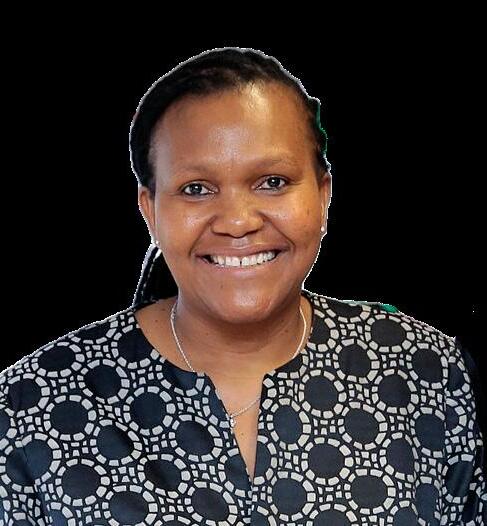
Renewed momentum for South Africa’s wind-energy future 46
Putting nuclear industrialisation at the heart of South Africa’s energy reboot
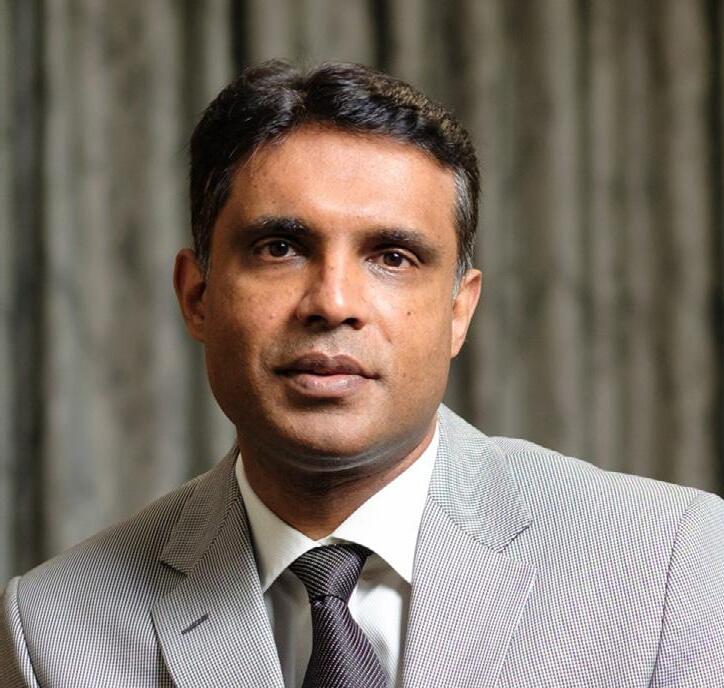
MyCiTi
It’s


























• GEMS Member Portal by clicking on “Login” at www.gems.gov.za
• Use the QR code to download the GEMS Member App
• The self-help facility by calling 0800 00 4367 and following the voice prompts






































































PUBLIC SECTOR LEADERS
The Digimag For Leaders In The South African Public Sector Fully Accredited Member of ABC

Advertising Sales, Distribution and Subscriptions
Top Media & Communications (Pty) Ltd
Tel: 086 000 9590 info@topco.co.za | www.topco.co.za
CEO Ralf Fletcher
TOPCO STUDIO
Production Director
Van Fletcher van.fletcher@topco.co.za
Group Editor
Fiona Wakelin
fiona.wakelin@topco.co.za


Deputy Editor
Koketso Mamabolo koketso.mamabolo@topco.co.za
Assistant Editor
Shumirai Chimombe shumirai.chimombe@topco.co.za
Contributors
Jessie Taylor
Wandile Sihlobo
Thulani Dube
Lisa Firer
Dr Phindile Nkosi
Calvin Nchabeleng
Design
Tashwell Brown
Cover Design
Nasreen Emeran
Traffic Manager
Daniël Bouwer artwork@topco.co.za
SALES
National Project Manager
Emlyn Dunn
Tel: 072 1263962 emlyn.dunn@topco.co.za
Brand Coordinators
Sidney Phiri
sidney.phiri@topco.co.za
Printers LAW Print Images iStock / Unsplash / GCIS | Flickr
Digital Publishing Platforms Issuu Magzter Media Carrier
Head Office
Top Media & Communications (Pty) Ltd T/A Topco Media Elkay House, 186 Loop St Cape Town
Tel: +27 86 000 9590
Fax: +27 21 423 7576
Email: info@topco.co.za Website: www.topco.co.za

DISCLAIMER
All rights reserved. No part of this publication may be reproduced, stored in a retrieval system or transmitted, in any form or by any means, electronic, mechanical, photocopying, recording or otherwise, without the prior written consent of Top Media & Communications (Pty) Ltd T/A Topco Media. Reg. No. 2011/105655/07. While every care has been taken when compiling this publication, the publishers, editor and contributors accept no responsibility for any consequences arising from any errors or emissions.
In times of loss, the concept of home takes on a deeper meaning. For families who have lost a loved one away from home – whether abroad or within the country – repatriation, the process of bringing them back to their place of origin, becomes more than just a logistical necessity. It is an emotional journey.
As the world becomes increasingly connected and remote work grows more common, more people – whether high-flying professionals or everyday families – are re-evaluating where they truly want to live.
Whether guided by cultural traditions, a desire for a final resting place among ancestors, or the comfort of familiarity, repatriating a departed loved one is a way of honouring their life and legacy. In a globalised world, it’s a deeply personal act that brings loved ones to their final place of rest – back to where their story began.
For many, the choice to work far from home – be it for financial, political, social or personal reasons – presents a unique set of challenges. One seldom discussed but vitally important for consideration is repatriation.
UNDERSTANDING REPATRIATION
What happens when someone passes away while working or holidaying far from home – locally or abroad? Would you or your family know what steps to take? Would you have the resources to bring them home?
In this context, repatriation refers to the transportation of a deceased loved one to their home country or place of origin. It is both a deeply emotional and logistical process – one that AVBOB approaches with care, dignity and professionalism.
“At AVBOB, our aim is to reunite loved ones with their families, no matter where in the world they may be. We provide a comprehensive repatriation service because we understand that closure, comfort and cultural respect matter deeply during a time of grief,” says Adriaan Bester, Executive: Funeral Products and Services at AVBOB
With more than 350 branches and a fleet exceeding 1 000 vehicles – including state-of-the-art refrigerated units – AVBOB is equipped to handle repatriation both across South Africa and internationally. Our vehicles meet all local and international legislation and safety standards, and our extensive network of funeral professionals ensures seamless coordination and compassionate care throughout the process.
Whether a loved one has passed away abroad, in another province, or in a remote part of the country, AVBOB’s Repatriation Hub stands ready to assist. Our goal is simple: to bring your loved one home with dignity and care.
WHY REPATRIATION MATTERS
Grieving is already a heavy burden. When a death occurs far from home, logistical complications, emotional stress, and unfamiliar environments intensify that burden.
REPATRIATION OFFERS FAMILIES
• greater control over funeral arrangements in a familiar setting;
• relief from complex legal or cultural requirements in foreign territories;
• the ability to honour cultural and religious customs, particularly the importance of laying a loved one to rest in their geographic or spiritual home;
• potential cost savings, particularly for extended families wishing to attend local funeral proceedings; and
• emotional comfort and closure, knowing their loved one is nearby and accessible for visits or memorials.










WHO CAN USE AVBOB’S REPATRIATION SERVICE?
• AVBOB policyholders
• Non-policyholders
• Independent funeral undertakers
• Corporates
• Government institutions
For AVBOB policyholders, domestic repatriation is included in their FREE funeral benefits* – a testament to our commitment to supporting South African families in times of need.
FIND PEACE OF MIND
Let AVBOB walk the journey with you so that when the time comes, you can grieve without worry and say goodbye in the place that feels most like home.
To make use of AVBOB’s Repatriation Service, contact our team on 074 899 5413 or email repathub@funeral.avbob.co.za.
For more information on repatriation visit: www.avbob.co.za/funeral-services/repatriation
Subscribe to Topco Media’s official Weekly newsletter as we keep you up-to-date with the latest business blogs and articles.
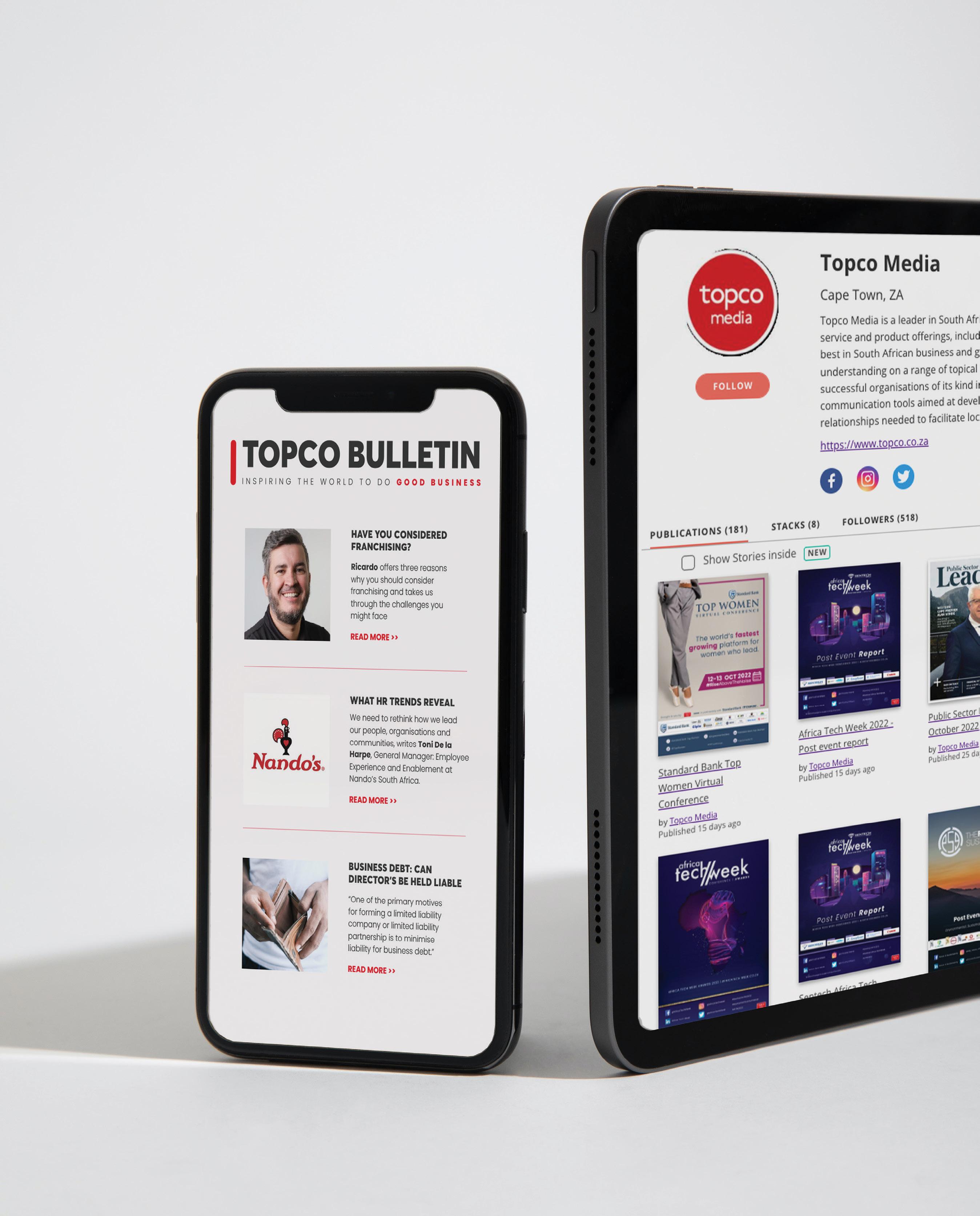

EDITOR’S LETTER
BY FIONA WAKELIN
Welcome to the November edition of Public Sector Leaders (PSL)

In his letter penned to the nation on November 17, His Excellency President Ramaphosa focused on “green shoots” - the signs of South Africa’s economic recovery.
Key economic indicators which reflect this include:
• The unemployment rate fell to 31.9% between July and September this year, down from 33.2% recorded in the previous quarter
• Nearly 250 000 more people were in employment in the third quarter – 130 000 of which were in the construction sector
“This is in no small part owing to the strength of the partnerships forged between government, business, labour and civil society. These far-reaching economic changes have a direct and material impact on the lives of every South African, on their ability to lead dignified lives, to access public services, to secure employment, and to provide for their families. We are determined to sustain the momentum of this economic recovery, so that we can drive inclusive growth, create jobs and improve the lives of our citizens,” – President Ramaphosa.
Our front cover pays homage to the all-important G-20 Summit happening in November – as does our lead article which takes a look at the key decisions and discussions which have led up to November 22 and 23. Inside, meet this month’s Women in Leadership, Mmakgoshi Lekhethe, CEO, IDC - and Trailblazer, Professor Deresh Ramjugernath, Stellenbosch University Vice-Chancellor. In Other News we look at MyCiti going digital; Financial Fitness takes a deep dive into solar tax incentives while our regular Sporting Action brings you an in depth look at Proteas’ skipper Laura Wolvaardt.
Fascinating features this month include a look at the feasibility of the Port of Gauteng (yes you read that correctly!), the MzansiXchange pilot launch which will offer improved service delivery and reduction in delays by streamlining administrative processes; secure, easy access to data between departments; elimination of redundant systems and the enablement of fraud detection and informed planning and decision-
making through access to data; plus a zoom into the Integrated Resource Plan 2025, with a focus on nuclear industrialisation. Speaking of industrialisation please read the article Industrialisation in Africa for insights regarding the African Development Bank Group’s approval of $75-million in financing to support South Africa-based Nyanza Light Metals Pty Ltd (Nyanza) through local value addition to the continent’s abundant titanium mineral resources.
Thulani Dube, Head of Innovation and Advancement, Cornerstone Institute takes a deep dive into bridging the digital divide by leveraging technology to drive inclusive leadership and sustainable socio-economic growth, while Wandile Sihlobo focuses on South African agriculture's attitude towards greater Africa.
Ending on a high note, South Africa has been removed from the grey list – which circles back to President Ramaphosa’s letter to the nation this week.
From myself and the amazing team, we hope you enjoy the read.

BY FIONA WAKELIN

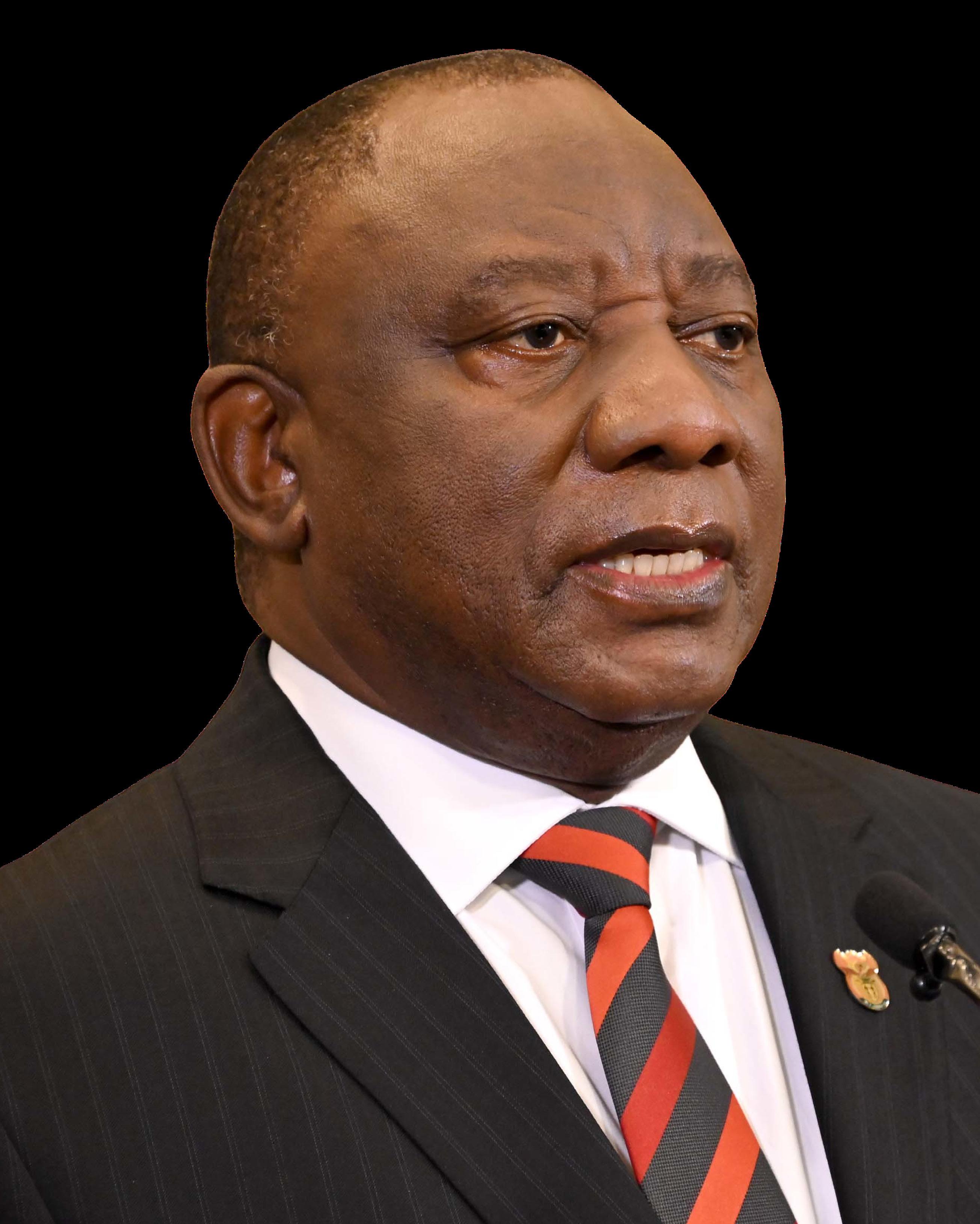


In his letter penned to the nation on November 17, His Excellency President Ramaphosa focused on the signs of South Africa’s economic recovery.
Key economic indicators which reflect this include:
• The unemployment rate fell to 31.9% between July and September this year, down from 33.2% recorded in the previous quarter
• Nearly 250 000 more people were in employment in the third quarter – 130 000 of which were in the construction sector
The Medium Term Budget Policy Statement reflected a sustained turnaround in government finances with a third consecutive primary budget surplus – which means, excluding interest payments, there is more revenue being collected than being spent. “Also last week, our sovereign credit rating was upgraded by S&P. This is the first such upgrade from the agency in nearly two decades. An improved rating generally leads
to lower borrowing costs, which allows for more funds to be invested in the economy and in meeting social needs. Among the factors S&P cited for the positive outlook were Eskom’s improved performance, strong tax collection and the broad structural reform momentum having ‘picked up pace.’
“When we established Operation Vulindlela in 2020 as a government coordinating mechanism to implement transformative reforms and boost economic growth, the initial focus was on the network sectors as well as immigration reform. We are seeing steady progress in the logistics sector, notably with respect to improved performance at our ports. Measures to allow private sector companies to operate on the national freight rail network are also at an advanced stage. In support of South Africa’s ratings upgrade, S&P cited the recently launched Phase II of Operation Vulindlela, which is focusing on changes in local government, digital transformation, visa regimes, spatial inequality and others.
“Modelling from the University of Stellenbosch’s Bureau of Economic Research (BER) has estimated that the potential impact of the Operation Vulindlela reforms could lift
South Africa’s long-term growth rate by as much as 3.5% when fully implemented. In citing this modelling, the analyst JP Landman writes that ‘the reforms are a journey, but they have started working. Step by step, South Africa is opening its economy, modernising infrastructure and rebuilding credibility’,” - President Ramaphosa.
His Excellency went on to invoke challenges of the last decade which included a global pandemic, a debilitating energy crisis and more recently, a difficult global trade environment, economic stagnation and capture of the state, despite all of which the green shoots are appearing.
“This is in no small part owing to the strength of the partnerships forged between government, business, labour and civil society. These far-reaching economic changes have a direct and material impact on the lives of every South African, on their ability to lead dignified lives, to access public services, to secure employment, and to provide for their families. We are determined to sustain the momentum of this economic recovery, so that we can drive inclusive growth, create jobs and improve the lives of our citizens,” – President Ramaphosa.
BY SHUMIRAI CHIMOMBE

G20 Finance Ministers and Reserve Bank Governors meeting 2
Over the course of the year, some 130 meetings have been held during South Africa’s G20 presidency. These have included working groups, Ministerial meetings, and various engagement groups which brought together civil societies, parliamentarians, think tanks, women, youth, labour, businesses and researchers of the G20 countries.
The outcomes of these meetings, held under the overarching theme Solidarity, Equality, Sustainability will inform the agenda for the G20 Leaders Summit - now on the horizon from 22 to 23 November.
Here are some of the key declarations and statements that emerged from the meetings.
Labour and Employment Ministers Meeting - Promoting a sustainable, resilient, inclusive, and prosperous future of work
On 31 July the G20 Labour and Employment Ministerial Declaration was adopted by the Ministers in which they affirmed their intention to promote a sustainable, resilient, inclusive, and prosperous future of work.
This was at the end of the two-day G20 Labour and Employment Ministers Meeting (LEMM) attended by about 150 delegates at the Fancourt Hotel and Country Estate in George, Western Cape. They included labour and employment Ministers, invited countries, labour, business, the EU, African Union and international organisations such as the International Labour Organisation (ILO), Organisation for Economic Cooperation & Development (OECD) and International Social Security Association (ISSA).
Presenting the Declaration, also known as the Fancourt Declaration, Employment Working Group (EWG) Chairperson and Department of Employment and Labour Acting Director General, Jacky Molisane said the document was an outcome of extensive work and deliberations of the EWG over the past months, and was shaped over four technical meetings held in Gqeberha, Umhlanga, Geneva and George.
Some key points in the declaration:
Ensuring decent work and decent lives
• We recognise that promoting decent work, including creating full and productive employment, good quality jobs, and ensuring the adequacy and sustainability of social protection systems, are fundamental for reducing inequality, broadening economic participation and boosting economic growth. We reaffirm our commitment to the G20 Policy Priorities
to Reduce Inequalities in the World of Work and commit to regularly review relevant trends, policies and programmes.
The four priority areas:
Inclusive growth, job creation and youth empowerment
• We will work with relevant agencies to improve the situation of young people in the labour market, including by increasing awareness, guidance and support to young people’s mental health and wellbeing, to enable them to start work, get back into work, stay and succeed in work.
• Recognising the importance of empowering young people and fostering innovation, we will promote youth entrepreneurship as a viable pathway to decent work by seeking to remove barriers to finance, supporting and enabling ecosystems for start-ups and supporting young people to take up leadership responsibilities and seize entrepreneurial opportunities.
Gender equality in the workforce
• To advance gender equality in the labour market, we will take steps to strengthen policy measures to tackle the multifaceted barriers that women face, including discriminatory social and cultural norms. These steps include implementing measures aimed at fostering women’s access to quality employment, leadership positions and to active labour market policies, supporting equal pay for work of equal value, expanding and improving access to social
protection, promoting work–life balance, encouraging policies for the equal provision and sharing of parental leave and provision of care giving benefits and quality care services, including child and older person care and increasing access to education, lifelong learning, apprenticeships and entrepreneurial opportunities.
• We are committed to advancing women’s full and equal participation across all sectors and all levels in the world of work, including in business leadership and roles in Science, Technology, Engineering and Mathematics (STEM), fully respecting their freedom to choose professional careers.
• We commit to promoting wage-setting mechanisms and wage protection policies. Adequate statutory or collectively negotiated minimum wages, when supported by effective measures to ensure coverage and compliance, remain an essential tool for addressing inadequate pay and low wage.
• We recognise the importance of strengthening labour market institutions and social protection systems to provide income security, reduce informality, and support career transitions across the life course.
• As the digital economy continues to evolve, it is necessary to bridge digital
BY SHUMIRAI CHIMOMBE
divides between and within countries, including the gender digital divide through a human-centred approach to leveraging digitalisation, including by enhancing labour and social protections.
• We recognise the importance of skilling, reskilling and upskilling opportunities to allow workers to navigate the digital economy more effectively.
The way forward
• As G20 Labour and Employment Ministers, we reaffirm our shared responsibility to promote a sustainable, resilient, inclusive, and prosperous future of work. We will continue coordinated implementation of the four priority areas we have discussed.
Trade and Investment Ministers Meeting: Strengthening global trade for inclusive growth and shared prosperity
The G20 Trade and Investment Ministers and invited international partners gathered in Gqeberha, Eastern Cape on 10 October. The knowledge partners included the AfCFTA Secretariat, AfDB, FAO, ITC, OECD, UNCTAD, UNIDO, WTO, South Centre and TIPS.
In his Chair’s Summary, Department of Trade, Industry and Cooperation Minister Mpho Parks Tau wrote that the meeting took place amid heightened uncertainty and complex challenges, including geopolitical and trade tensions, disruptions to global supply chains, high debt levels, and rapidly frequent extreme weather events and natural disasters, which impact trade and investment.
In the context of these challenges, most Members emphasised the importance of strengthening multilateral cooperation to address existing and emerging risks to the global economy. They also recognised the important role and function of the World Trade Organisation (WTO) in facilitating and advancing trade.
Although the majority of G20 members agreed with the outcomes proposed by the South African Presidency in relation to trade and investment, some members could not agree to some issues in view of the challenges confronting global trade. Therefore the outcome of the meeting was the G20 Trade and Investment Ministerial Statement.
Some of the points in the statement include:
• We will strive to ensure that the benefits of trade reach all segments of society and that all our people have the opportunity to benefit from trade. We encourage value addition throughout value chains and recognise the need for a trade and investment agenda that addresses global challenges.
• We recognise the important role that trade and investment policies can play in supporting industrialisation. We discussed the South African presidency's priority on how to enable sustainable industrialisation and development, and note the widely divergent perspectives expressed by Members, including on how they seek to industrialise.
4th Finance Ministers & Central Bank Governors Meetingtaking action to enhance debt sustainability
The G20 Finance Ministers and Central Bank Governors convened for a two-day meeting from 15 to 16 October on the sidelines of the Annual Meetings of the International Monetary Fund (IMF) and World Bank in Washington, DC. The Finance Track is cochaired by Finance Minister Enoch Godongwana and South African Reserve Bank (SARB) Governor Lesetja Kganyago.
The meeting resulted in the Ministerial Declaration on Debt Sustainability to address the challenges that many vulnerable Iow- and middle- income countries (LICs), particularly in Africa, face with high financing costs, large external refinancing needs, and a significant outflow of private capital.
Some key actions the Ministers committed to in the Ministerial Declaration to further enhance debt sustainability:
• We recognise that a high level of debt is one of the obstacles to inclusive growth in many developing economies, which limits their ability to invest in infrastructure, disaster resilience, healthcare, education and other development needs.
• We reaffirm our commitment to support efforts by low- and middle-income countries to address debt vulnerabilities in an effective, comprehensive and systematic manner.
• We reiterate our commitment

BY SHUMIRAI CHIMOMBE
to further strengthen the implementation of the Common Framework for Debt Treatments beyond the DSS’ in a predictable, timely, orderly, and coordinated manner
• We reaffirm our call to enhance debt transparency from all stakeholders, including private creditors. We support the ongoing review of the International Monetary Fund (IMF) - World Bank Low Income Countries Debt Sustainability Framework (LIC-DSF), which will result in further improving the methodology underpinning the IMF-World Bank Debt Sustainability Analysis (DSA) for LICs and thus contribute to understanding and addressing debt vulnerabilities more effectively.
• We remain committed to engaging constructively with key stakeholders in further advancing common understanding, including with the private sector, official bilateral and multilateral creditors and debtor countries. It is important to engage with and enhance the voice of borrower countries.
• We continue to urge the international community to support vulnerable countries with a strong reform agenda whose debt is sustainable but are facing liquidity challenges, and encourage the IMF and the World Bank to continue their work on feasible options to support these countries, which should be country-specific and voluntary. We will also discuss how to support these countries, with the support of the IMF and World Bank.
South Africa’s G20 legacyamplifying Africa’s voices on the global stage
Speaking to the media on 17 November on the country’s preparations ahead of the G20 Leaders’ Summit, Minister of International Relations and Cooperation, Ronald Lamola said that South Africa’s G20 Presidency has not only elevated African voices, but galvanised global momentum toward a more inclusive, equitable and sustainable future.
“Our Presidency is a call to action as the last nation of the Global South to hold the Presidency in this cycle. A call to bridge the developmental divide between the Global North and the Global South, to champion equity, sustainability, and shared prosperity.”
Minister Lamola outlined four key priorities that have anchored South Africa’s Presidency:
• Strengthening disaster resilience - advocate for financing tools to help vulnerable countries rebuild after climate-induced natural disasters
• Ensuring debt sustainability for low-income countriesadvance sustainable solutions to tackle the crippling debt burdens that restrict growth in low-income nations
• Mobilising finance for a just energy transition - increase the quality and quantity of climate finance flows to developing countries to support them in shifting to clean energy while ensuring social and economic benefits
• Harnessing critical minerals for inclusive growthAdvocate for value addition, industrialisation, and green
manufacturing in Africa, rather than just raw resource extraction, and champion the use of critical minerals as an engine for growth and sustainable development in Africa
The key achievements highlighted include:
• A highly successful G20 HighLevel Dialogue in Addis Ababa on debt sustainability and capital costs
• Establishment of the Africa Expert Panel chaired by former South African finance minister Trevor Manuel, which recently submitted its report to President Ramaphosa calling for the G20 countries and the IMF to adopt sweeping measures to refinance lowincome debt
• A renewed and broadened and Agenda 2063-aligned Compact with Africa - a G20-endorsed platform dedicated to mobilise private investment in Africa
All hands on deck for the G20 Leaders Summit
Minister Lamola described South Africa’s G20 Presidency - the first ever on African soil - as a decisive moment for the continent and the broader Global South.
“As the G20 Leaders’ Summit begins, South Africa stands poised not just as host but as a global convener of solidarity, reform, and shared prosperity.”
The Summit will take place from 22-23 November in Johannesburg. The SABC will provide the official G20 news feed to the G20 member countries, as well as 50 additional nations and multiple international news agencies

BY DR PHINDILE NKOSI

Imagine family time on a Saturday evening in Johannesburg during winter. In Sandton, a family gathered around the wood-fired fireplace in a perfect, cozy scene. A few streets away, another family is celebrating a friend's achievement over a braai; there is contagious laughter, the aroma of wood smoke, and drinks. Across the freeway, a woman in Alexander township prepares a meal for her family over a wood fire in a small, enclosed kitchen.
One thing is common in these scenarios: exposure to harmful particulate matter from wood smoke, which is consequential for both physical and mental health, especially affecting the most vulnerable groups in society1. The World Health Organization puts indoor air pollution risk in the same category as smoking tobacco. Approximately 3.7 million people die prematurely each year from household indoor pollution. Women and children appear to be the most vulnerable to this serious public health concern. This is because women spend a significant amount of time with children and are responsible for most of the
domestic chores, such as cooking in the household.Transitioning towards clean fuels is undoubtedly a crucial concern for energy security, economic stability, and public health. However, when the motives for using clean fuels differ significantly among social classes, transitioning towards them can be a daunting task. The Alexander township mother uses wood out of necessity to survive or shield against energy security concerns (i.e. power outages and high electricity costs). At the same time, the wealthy families do it for comfort or ambiance. The motives of 'security' versus 'convenience' pose a use dilemma, one that requires a tactfully designed policy to address
.
In October 2025, at the Energy Transitions Ministerial Meeting in KwaZulu-Natal, clean cooking was elevated from an overlooked challenge to the mainstream G20 agenda, as the Electricity and Energy Minister, Kgosientsho Ramokgopa, termed it a "major victory."
The commitment was expressed as a human rights issue. The Minister noted: “There's a young girl somewhere in a remote village who comes back from school, drops her books, and goes to fetch firewood. That's what we want to change.”
The decision is timely, considering that almost a billion people in Africa lack access to clean cooking2 . However, South Africa's experience reveals uncomfortable truths. Despite significant electrification progress of over 90% by 2023, some households still prefer to cook with wood. The 2023 General Household Survey by Stats SA indicates that nationally, about 7.8% of households still prefer to use wood as cooking fuel. In provinces such as Limpopo and Mpumalanga, fuelwood use accounted for 31% and 18%, respectively. This suggests that access to infrastructure alone is insufficient for adoption. The existence of an electrical connection does not guarantee its use. Behind the grid statistics lie social and behavioural barriers - namely, awareness, affordability, and power dynamics within the household. ENERGY

The awareness gap
The awareness of the negative impacts of using solid fuels is perceived to be high among affluent households. However, such knowledge is lacking across income levels. Research3 shows that affluent South African households burn wood for recreational purposes, unaware of the associated risks. Burning wood produces delicate particulate matter (PM2.5 and PM10)4, contributing to indoor air pollution that negatively impacts health and development. Indoor air pollution from burning wood is the leading cause of respiratory illnesses, cardiovascular diseases, and premature deaths. The WHO states that inhaling PM2 more than 3 days a year is detrimental to human health. Now imagine the length of winter in South Africa. This means households inhale wood smoke that exceeds the recommended standard guidelines set by the WHO for open and closed fireplaces. For the most part, affluent families can afford the health costs associated with indoor air pollution.
How about poor households that have to inhale wood smoke while making daily meals to live? Lowand middle-income women are estimated to cook two to three times a day, spending two to four hours inhaling wood smoke. Some carry infants on their backs while cooking, multiplying the risk. Given the limited economic power that restricts their access to health facilities, women and children from lowand middle-income households face a higher risk of exposure to indoor air pollution. Providing information/awareness about the adverse effects of solid fuel use should not be discriminatory between high- and low-income homes; however, for lowincome homes, it requires the additional support of 'resource backing'.
The income threshold - When more money doesn't mean cleaner cooking In energy transitions, increased income is generally expected to translate to cleaner fuel use. This is not always the case. Different households simultaneously use multiple energy sources rather than fully transitioning to modern energy (i.e., fuel stacking phenomenon). This behavior is influenced
by various factors, including choice (i.e., whether to use the fireplace scenario or opt for cooking with wood), affordability constraints, unreliable electricity, and a cultural attachment to traditional fuels. The relationship between income and energy use is non-linear - specific income thresholds mark significant changes in energy behaviour.
A recent study, conducted using the National Income Dynamics Survey (NIDS)'s multiple waves of household panel data, reveals that energy behaviour changes in nuanced and often unexpected ways as incomes evolve. A threshold was determined in urban areas. Above the threshold, households spent more on modern energy sources, such as electricity5. This could reflect the widespread availability of electricity infrastructure in urban areas and the economic viability of electricity consumption at high-income levels.
But here's where it gets interesting: the threshold found among rural households did not translate to increased clean energy expenditure. Instead, households below the threshold spent less on electricity. Electrified rural households stacked traditional wood fuel with modern energy sources, primarily due to the availability of and easy access to wood fuel, as well as concerns about energy security (i.e., supply reliability and uncertainty around cost). Thus, in rural areas, households below certain thresholds often prioritise subsistence needs over clean energy consumption. A typical scenario is where a poor household decides to sell a clean cookstove, which was allocated for free, to satisfy their immediate needs and continue using the freely available solid fuels.
In sum, the research acknowledges the complex relationship existing between income and energy transition, which must be carefully studied in different geographic and social contexts. Additionally, the research emphasises the importance of considering non-income factors in the transition process; one of which is the underexplored intrahousehold bargaining power
BY DR PHINDILE NKOSI
The household use of traditional solid fuels has gendered implications. First, the collection of wood fuel, which is mainly done by women in society, involves a significant opportunity cost. Women lose effective labour hours in collecting fuel, with negative welfare implications. Second, women often do most of the household cooking, which means they have high exposure to indoor air pollution from wood fuel smoke. This compromises the health of women and their accompanying children significantly. The effective labour hours lost and the health effects associated with collecting wood fuels and cooking create an energy injustice for women in society.In the equality discourse, women are active recipients of welfare, and their empowerment can positively influence the economic productivity and well-being of those around them. Gender equality is central to achieving some of the Sustainable Development Goals. Thus, transitioning from traditional to clean energy sources redresses gendered welfare and health gaps at the household level. Intrahousehold dynamics, particularly the distribution of bargaining power, have been identified as key determinants of household energy decisions in genderfocused studies.
Generally, women's bargaining power within households has been found to positively impact children's health, educational outcomes, and the overall well-being of women and girls. Women are
typically the primary users of household energy, but often lack the decision-making authority owing to entrenched gender norms and inequalities. Women's intrahousehold bargaining power increases the use of clean energy and the adoption of improved cooking stoves6,7. Men, who often control financial resources in many households, may not prioritise the shift to clean energy because they are not directly involved in using dirty fuels, as household chores are often considered women's jobs. In some countries, men are shown to have had more bargaining power but were not interested in buying clean cookstoves8 . Women's exclusion from decision-making diminishes their ability to advocate for adopting clean energy, thereby perpetuating energy poverty and reinforcing broader gender disparities. Research in South Africa has shown that women's bargaining power influences the household's choice of cooking fuel. Results showed an increased likelihood of choosing clean fuels when women have power in household decision-making. This power dynamic extends to heating fuels, underscoring the importance of women's negotiating power as a non-income driver of household energy transition. In view of this, traditional income/price instruments to facilitate a clean transition should complement policies that enhance women's bargaining power, such as women's empowerment.
Policy implications: Blind spots the G20 must consider Understanding household realities is crucial to the success of energy transitions. Infrastructure remains vital, but its impact depends on household behavior and outcomes. The G20 clean cooking initiative is essential and timely. The commitment advocates for infrastructure, financing, bridging the knowledge gap, market and skills development, and enterprise opportunities for the marginalised groups.
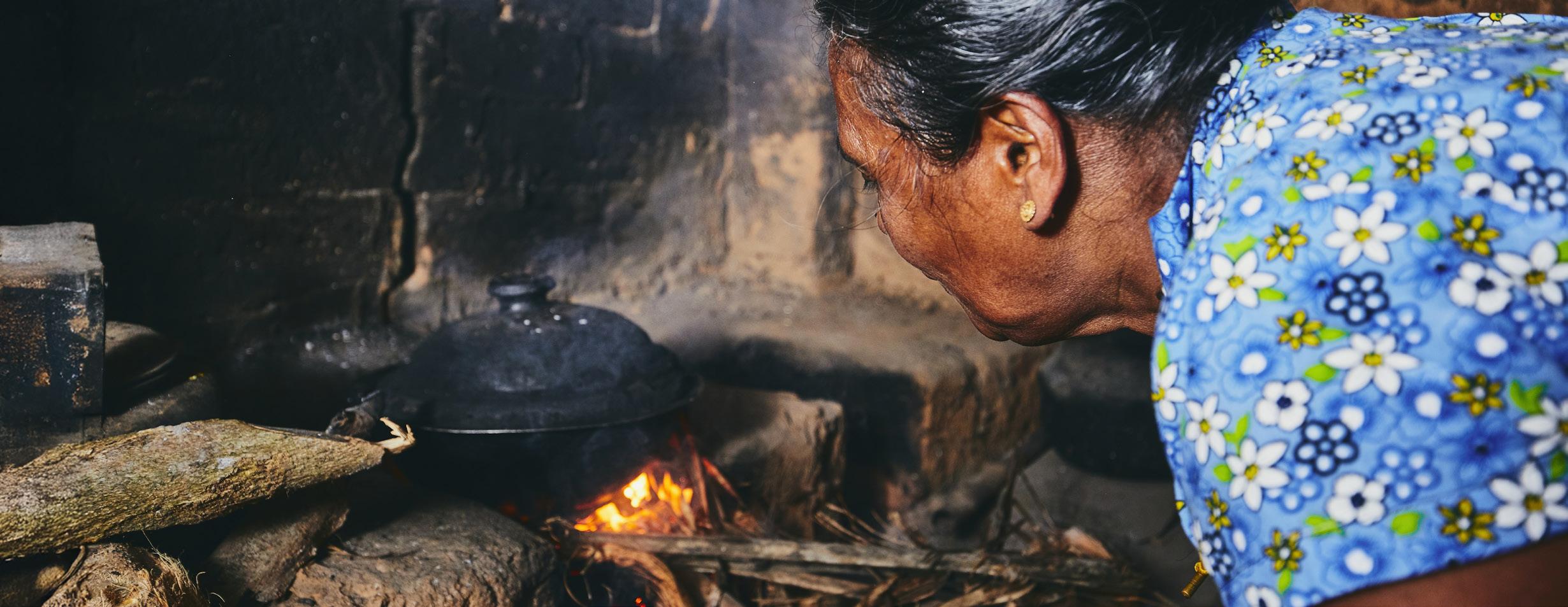
The following complementary interventions are necessary:
Health awareness campaigns: Households need to understand the health impacts associated with inhaling smoke from solid fuels. Cultural preferences may keep them from transitioning, but once they know the negative health impacts, adoption may improve.
Affordability mechanisms: Government subsidies need to be designed around income thresholds to be effective. Otherwise, there would be no incentive for struggling households to switch to clean cooking if the money could be used for immediate needs. Gendered policies: Employment or income alone may not translate to adoption, especially in patriarchal societies, where women's decisionmaking authority is often constrained. Policymakers should consider implementing policies such as cash transfers targeted at women and programs that promote women's labour market participation. Having women at the forefront of the clean energy sector can improve the uptake of clean energy sources.
Final thoughts: Seeing beyond the grid South Africa's puzzle—high electricity access yet persistent wood use—presents a compelling reason
End notes:
1. Misra, A., Longnecker, M. P., Dionisio, K. L., Bornman, R. M. S., Travlos, G. S., Brar, S., & Whitworth, K. W. (2018). Household fuel use and biomarkers of inflammation and respiratory illness among rural South African Women. Environmental Research, 166, 112-116. https://doi.org/10.1016/j.envres.2018.05.016
2. International Energy Agency (IEA). (2023). A Vision for Clean Cooking Access for All. IEA, Paris. https://www.iea.org/reports/a-vision-for-clean-cooking-access-for-all
3. van der Walt, R. E., Jacobs, R., Grobbelaar, S. S., & Booysen, M. J. (2024). Lifting the unseen smokescreen on indoor air quality due to amenity indoor fireplaces in South African homes. Energy Research and Social Science, 114, 103597. https://doi. org/10.1016/j.erss.2024.103597
4. PM stands for Particulate Matter, which are particles suspended in the air causing air pollution. PM2.5 represents smaller particles that can penetrate lungs and bloodstream causing stroke or lung cancer, while PM10 are larger particles that can end up in the upper respiratory tract.
to consider these factors. While developing their clean cooking implementation plans, G20 nations need to consider household awareness, income thresholds, and women's decision-making power in the household. Women, who bear the brunt of solid fuel use, must have power in household decision-making to choose clean fuels. Targeted policies can lead to desired outcomes. There must be an understanding of the full spectrum of household realities to achieve energy justice.
About the Center:
The Public & Environmental Economics Research Centre (PEERC), within the School Economics at the University of Johannesburg, bridges the gap between rigorous academic research and practical policy implementation. Our multidisciplinary team of economists employ advanced econometric modelling and policy analysis to address pressing challenges in fiscal policy, climate change, water management, food security, energy transitions, and sustainable development. Through strategic partnerships with government departments and industry stakeholders, we deliver evidence-based research that drives tangible social and economic change across Southern Africa, empowering leaders with the insights needed to navigate complex policy landscapes and build a more sustainable future.
Dr
Phindile Nkosi, Director: Public & Environmental Economics Research Center (PEERC), School of Economics, College of Business and Economics, University of Johannesburg
5. Electricity was categorised as clean compared to solid fuels, since it is not combusted at a household level, affecting household health.
6. Doss, C. R. (2021). Diffusion and dilution: The power and perils of integrating feminist perspectives into household economics. Feminist Economics, 27(3), 1-20. https://doi.org/10.1080/13545701.2021.1883701
7. Adusah-Poku, F., Dramani, J. B., & Adjei-Mantey, K. (2023). Does the choice of cooking fuel empower Ghanaian women? An empirical analysis. Development Southern Africa, 40(4), 791- 808. https://doi.org/10.1080/0376835X.2022.2135489
8. Ochieng, C. A., Murray, U., Owuor, J., & Spillane, C. (2021). The forgotten half: Men’s influence over cookstove adoption decisions in Northern Kenya. Energy Research and Social Science, 74, 101913. https://doi.org/10.1016/j.erss.2021.101913
Image of cooking woman: Energy and Climate Partnership of the Americas (ECPA). (n.d.). The persistent challenge of access to clean cooking [Newsletter].


BY JESSIE TAYLOR

In February 2025, Mmakgoshi Lekhethe became the first woman to take the helm of the Industrial Development Corporation (IDC), one of South Africa’s most influential development finance institutions. Her appointment marks a significant milestone in both the transformation of leadership in the industrial-finance sector
and the broader imperative of inclusive growth in the South African economy. The IDC is a state-owned development finance institution established in 1940 to promote industrial growth and economic transformation in South Africa. It provides funding and strategic support to businesses across sectors such as manufacturing, mining, energy, agriculture,
and technology. The IDC’s mandate is to drive sustainable industrialisation, create jobs, and support black-owned, women-led, and youth enterprises. It plays a key role in advancing localisation, green economy initiatives, and regional integration across Africa. Through its investments, the IDC aims to build a more inclusive, competitive, and resilient industrial base for South Africa’s long-term development.
Historic appointment, bold vision Born in Lydenburg in Mpumalanga and raised in the mining town of Burgersfort, Ms Lekhethe was the only sister among four brothers. As she recalled, growing up in that environment taught her early lessons around responsibility, numbers and trust while helping at her father’s general dealership during school holidays. Her mother, a primaryschool principal, instilled discipline and a strong work ethic; her father’s entrepreneurial instincts provided the spark for understanding business contexts at a young age.
Post-1994, Ms Lekhethe joined the National Treasury, where she would build a 20-plus-year career in public finance, rising through the ranks and gaining international experience via secondments to institutions such as the African Development Bank, the New Development Bank and the World Bank.
These assignments provided her with exposure to macro-economic policy, regional integration, development financing and the transition to a green growth economy. For example, while at Treasury she was involved in negotiating the US$8.5 billion funding package for South Africa’s just energy transition.
When the IDC’s board recommended her appointment - subsequently approved by Cabinet on 4 December 2024 - Minister Parks Tau described her selection as a “historic milestone”, signalling the government’s commitment to gender-diverse leadership in critical economic institutions.
Ms Lekhethe assumed her role in February 2025, taking charge of an institution with an 85-year legacy in industrial development. She acknowledges the responsibility of leading such a large organisation, particularly as the first female CEO in its history. As she put it, “Being the first female CEO is an immense responsibility.” Her view is anchored in both optimism and pragmatism. She entered the role not with preconceived ideas of “this works / this doesn’t” but with curiosity, a willingness to learn and a readiness to lead a transformation-focused agenda.
Under her leadership, the IDC is tasked with driving sustainable economic growth, industrialisation, entrepreneurship, and job creation - especially for previously disadvantaged groups, including black-owned businesses, women entrepreneurs and youth.
Key strategic areas that Ms Lekhethe is focusing on include:
• Building strategic partnerships and alliances as the IDC seeks to expand into emerging sectors such as green hydrogen, critical minerals value chains, agro-processing and renewable energy.
• Retaining critical skills within the organisation, recognising competition for talent in financial institutions as a challenge. Lekhethe highlights this as one of her top priorities.
• Ensuring the IDC remains agile and responsive to emerging global and domestic economic headwinds, and leveraging its historical mandate and institutional capacity to shape South Africa’s transformation agenda.
Ms Lekhethe attributes part of her success to the mentorship she received from senior leaders such as Maria Ramos and Gill Marcus, and she is now actively mentoring women leaders across South Africa and the continent.
With the global economic landscape undergoing rapid transformation and pressure on South Africa’s economy mounting, the IDC under Ms Lekhethe’s stewardship has a critical role to play. Positioned at the intersection of industrial policy, finance, transformation and sustainability, the corporation must catalyse new growth industries, support black industrialists, and foster inclusive job creation. Lekhethe believes the opportunities are immense. “Our road is as important now as it has been in the past,” she said. “We need to go into the continent for growth.”
Certainly, challenges remainincluding the need to heighten awareness among emerging entrepreneurs of the IDC’s funding programmes, and to ensure the developmental mandate translates into real-world impact for women, youth and township enterprises. But with Lekhethe at the helm, the tone is one of momentum, stewardship and inclusive ambition.
BYJESSIE TAYLOR

When Stellenbosch University (SU) formally installed
Prof Deresh Ramjugernath as its 13th Rector and Vice-Chancellor on 1 October 2025, the ceremony was not simply one of tradition and pageantry. It marked the beginning of a purposeful chapter for one of Africa’s premier institutions of higher learning - an era in which ambition, transformation and
impact converge. On taking office as Rector and Vice-Chancellor, Prof Ramjugernath laid out a bold vision: to position SU among the top 100 universities globally and as Africa’s leading research-intensive institution. His leadership framework is built around three core focus areas: academic excellence; people, culture and processes; and partnerships and sustainability.
A foundation of redefining academics
Born and raised in Durban, South Africa, Prof Ramjugernath’s journey into academia and leadership is rooted in a personal determination to transcend ordinary limitations. At just 31, he became a full professor in his field at the University of KwaZulu-Natal (UKZN), thereby
becoming the youngest professor in his discipline in Africa. His research excellence is extensive: over 350 peer-reviewed publications, more than 130 master’s and doctoral students supervised, and multiple patents and industry collaborations. His area of specialisation - chemical thermodynamics and separation technology - has direct relevance to South Africa’s industrial and resourceeconomy context, aligning scholarship with country-level priorities.
Before assuming the top leadership role at SU, Prof Ramjugernath was already embedded in its senior management, serving as Deputy Vice-Chancellor: Learning and Teaching from January 2021. Prior to that, he had held senior executive positions at UKZN, including Deputy Vice-Chancellor: Research and Pro Vice-Chancellor: Innovation, Commercialisation and Entrepreneurship.
One of the hallmarks of Prof Ramjugernath’s approach is his emphasis on belonging, empowerment and support. He frequently stresses that creating a sense of belonging is as important as academic achievement. In his view, universities must not merely educate, but empower - offering students not just technical knowledge but the skills, support and mindset to thrive in a complex world. He has also underscored the need for a genuinely inclusive, multicultural and multilingual institutional cultureone that embraces transformation as more than numerical targets, but as lived practice.
Source:
Embracing transformation and societal impact
Prof Ramjugernath also views SU’s role as deeply entwined with societal impact. He sees the university’s research-intensive profile not simply as a badge of prestige, but as a means of “solving real societal challenges, from HIV and TB to diabetes and cancer, while embedding transformation, equity and inclusion across the institution”.
Financial, social and environmental sustainability also feature prominently in his agenda. He has highlighted that universities face profound challenges around funding, student debt, accommodation shortages and food insecurity - and that meeting these demands is critical to ensuring sustainable progress.
Under Prof Ramjugernath’s stewardship, SU is expected to deepen its partnerships with government, industry, civil society and global institutions. He contends that interdisciplinary collaboration and internationalisation are vital to elevating SU’s profile and impact. Importantly, he frames SU’s ambition within the African context: the aspiration is not only to be a top global university, but to be Africa’s leading research-intensive institution - what he calls “playing a bold, big game”.
As Prof Ramjugernath stepped into the role of Rector and Vice-Chancellor, he acknowledged both the weight of the institution’s legacy and the urgency of new times. In his inaugural address he described himself as “only a steward entrusted … to shape new
and meaningful pathways to a better future for all at our institution.”
Critically, his leadership comes at a moment when higher education in South Africa is facing significant headwinds - from funding pressures to the imperative of societal relevance, from digital disruption to transformation imperatives. Yet within these challenges, he sees opportunity.
Prof Ramjugernath’s journey is emblematic of how academic achievement, leadership ambition and societal commitment converge. His story underscores how a university leader can combine deep scholarly credentials with a strategic, inclusive vision - one that aligns institutional excellence with societal progress. SU under his leadership is not simply seeking incremental advancement; it is signalling a willingness to recalibrate, reimagine and lead.
As Stellenbosch University embarks on this trajectory, the importance of patience, perseverance, and partnership cannot be understated. But with Ramjugernath at the helmwith his passion for teaching, research, transformation and impact - the institution seems poised to harness its legacy for a future defined not only by rankings or recognition, but by relevance, inclusivity and service.
In a time when educational institutions must do more than operate in silos, Ramjugernath’s vision of a university that empowers, engages and evolves is refreshing. He invites staff, students, alumni and partners alike to “shape tomorrow together – one conversation, one breakthrough, one act of courage at a time.”
BY SHUMIRAI CHIMOMBE

South Africa was officially removed from the Financial Action Task Force (FATF) grey list, on 24 October after successfully implementing key reforms to combat money laundering and the financing of terrorism.
FATF president Elisa de Anda Madrazo made the announcement following a plenary session held in Paris from 22-24 October. She said the outcome was the result of sustained efforts across authorities and also supported by the global network community. “A record of four countries have been removed from the grey list. This is the list of countries under increased monitoring - the so-called grey
list. The countries are Burkina Faso, Mozambique, Nigeria and South Africa. Some of the actions taken by these jurisdictions, include, in the case of South Africa, they have sharpened the tools to detect money laundering and terrorist financing”, said Ms Madrazo.
South Africa was placed on this list, formally called the list of “Jurisdictions under Increased Monitoring”, in February 2023 for not complying with international standards around the prevention of money laundering, terrorist financing and proliferation financing. When the FATF places a jurisdiction under increased
monitoring, it means the country has committed to swiftly resolve the identified strategic deficiencies within agreed timeframes and is subject to increased monitoring.
According to Investec, while the grey list is designed to improve international safety and security by curbing money laundering and the financing of terrorism and proliferation, it can have indirect implications for a country's international reputation, financial system and economy, and can affect foreign investment, access to international financial services, and long-term prosperity
The Financial Action Task Force (FATF) - a global watchdog
The FATF leads global action to combat money laundering, terrorist and proliferation financing, as well as other threats to the integrity of the international financial system. The 40-member body researches how money is laundered and terrorism is funded, and sets international standards to ensure national authorities can effectively go after illicit funds linked to drugs trafficking, the illicit arms trade, cyber fraud and other serious crimes. It promotes the effective implementation of these standards, and conducts mutual evaluations of member countries to assess their compliance with the FATF recommendations.
According to the FATF more than 200 countries and jurisdictions have committed to implement the FATF’s Standards as part of a co-ordinated global response to preventing organised crime, corruption and terrorism.
The FATF's decision-making body, the FATF Plenary, meets three times per year and holds countries to account if they do not comply with the Standards. If a country repeatedly fails to implement FATF Standards then it can be named a Jurisdiction under Increased Monitoring (grey list) or a High Risk Jurisdiction (black list)
Key reforms undertaken by South Africa to exit the grey list
Earlier this year in June, the FATF announced that South Africa had largely addressed all 22 action items outlined in the Action Plan it agreed to when it was placed on the organisation’s grey list in 2023. The decision then cleared the way for an on-site assessment – the penultimate step before South Africa could be officially removed from the grey list. The National Treasury
explained in a statement that: “Over the past 32 months, South Africa has engaged with a team of reviewers assigned by the FATF to assess progress against the Action Plan. This culminated in an on-site visit at the end of July 2025, when the assessors came to the country to confirm the sustainability of the reforms that had been reported to them,”
This concluded with a meeting with Deputy Minister of Finance, Dr David Masondo, and Deputy Minister of Justice and Constitutional Development, Andries Nel, who assured the FATF of the South African Government’s political commitment to continue to sustainably improving the country’s Anti-Money Laundering and the Combating the Financing of Terrorism (AML/CFT) system.
“South Africa’s progress in addressing the AML/CFT deficiencies and exiting the FATF greylist represents a major policy and institutional achievement for the people of South Africa, particularly following the weakening of key law enforcement and other institutions during the state capture era.”
Some of the key steps taken by South Africa to address AML/CFT include:
1. Demonstrating a sustained increase in outbound Mutual Legal Assistance (MLA) requests that help facilitate money laundering/financing of terrorism (ML/TF) investigations and confiscations of different types of assets in line with its risk profile. “Outbound MLA requests” refer to requests sent by one country to another to seek help in criminal investigations or proceedings. They are formal appeals made
by a country’s authorities to a foreign government for assistance in matters related to criminal justice that cross international borders.
2. Improving risk-based supervision of designated non-financial businesses and professions (DNFBPs) and demonstrating that all AML/ CFT supervisors apply effective, proportionate, and effective sanctions for noncompliance
3. Ensuring that competent authorities have timely access to accurate and up-to-date beneficial ownership (BO) information on legal persons and arrangements and applying sanctions for breaches of violation by legal persons to BO obligations
4. Demonstrating a sustained increase in law enforcement agencies’ requests for financial intelligence from the Financial Intelligence Centre for its ML/TF investigations
5. Demonstrating a sustained increase in investigations and prosecutions of serious and complex money laundering and the full range of TF activities in line with its risk profile
6. Enhancing its identification, seizure and confiscation of proceeds and instrumentalities of a wider range of predicate crimes, in line with its risk profile
7. Updating its TF Risk Assessment to inform the implementation of a comprehensive national counter financing of terrorism strategy; and
8. Ensuring the effective implementation of targeted financial sanctions and demonstrating an effective mechanism to identify individuals and entities that meet the criteria for domestic designation.
BY SHUMIRAI CHIMOMBE
Going forward - staying off the grey list
Speaking to SABC News after the announcement Technical Adviser at National Treasury, Ishmael Monet, said that being removed from the grey list demonstrates confidence in the country's ability to deal with money laundering and strengthening its financial systems. “Our policy framework is among the best in the world. Our problem is implementation. We did very badly in effectiveness.”
Some of the challenges he pointed out were a poor ability
to implement the laws, to get enforcement done, and to supervise properly against money laundering. “And yes, getting off the grey list just means that FATF believes that we don't need to be monitored to begin to do the right things. - and to do the right things for us as a country, not just for FATF. We have started doing the right things. We still have a long way to go. We still have to get to the criminals.”
He pointed out examples such as the Commission of Inquiry into Criminality, Political Interference,
and Corruption in the Criminal Justice System – informally known as the Madlanga Commission after its chairperson, retired acting Deputy Chief Justice Mbuyiseli Madlangawhich started its hearings on 17 September 2025.
Also the case of the Special Investigating Unit (SIU) probe into corruption at Tembisa Hospital in Gauteng that uncovered three coordinated syndicates responsible for the looting of over R2-billion. This led to the Gauteng Department of Health announcing

that it had suspended six of the nine officials that were identified in the SIU’s report. Also the Deputy Director for Supply Chain has since retired, a chief physiotherapist has resigned, and a sessional Medical Officer has since stopped working at the facility.
National Treasury emphasised that while exiting the grey list is an important milestone and a demonstration of South Africa’s commitment to rebuilding the rule of law, it is only the start of a broader process to continue to strengthen key institutions,
improve enforcement and governance processes, and ensure that such improvements are sustainable and systems become increasingly effective in combating the following: money laundering, terrorism financing and proliferation financing.
“Neither government agencies nor regulated entities in the private sector can afford to become complacent and stop improving. Instead, through public-private collaboration, they must continue to strengthen the AML/CFT system.”These actions will form
the basis of the next FATF Mutual Evaluation for South Africa, which is expected to commence in the first half of 2026 and conclude in October 2027. “To prevent being placed back on the grey list, it is important that systems of monitoring and enforcement work more efficiently and effectively, and that there are no gaps, by the time of the mutual evaluation. Preparations, in this regard, have already begun and we remain confident that South Africa will be able to sustain the progress made.” - National Treasury

INDUSTRIALISATION IN AFRICA
BY SHUMIRAI CHIMOMBE

In a major boost for industrialisation in Africa, the African Development Bank Group (AfDB) announced on 28 October that it had approved $75-million in financing to support South Africa-based Nyanza Light Metals Pty Ltd (Nyanza) through local value addition to the continent’s abundant titanium mineral resources.
Based in the Richards Bay’s Industrial Development Zone, with corporate offices in Johannesburg, Nyanza manufactures titanium dioxide (TiO₂) pigment and other chemicals.
Titanium dioxide is a crucial pigment used across numerous industries, including
paints and coatings, food processing, cosmetics, and medical applications. According to Nyanza, Africa accounts for 45% of the global titanium reserves, yet despite this, every year the continent spends over $600-million dollars importing titanium dioxide pigment alone.
“The lack of mineral beneficiation and value addition capacity on the continent has severely handicapped further industrial economic and social development. But thanks to the trailblazing efforts of the Nyanza Light Metals this is set to change. This pioneering project heralds a major milestone in the development of the titanium value addition industries, and will see South Africa and
the African continent finally benefit from their vast mineral reserves.”
Rob Mhishi, Nyanza COO said: “Once completed Nyanza's $550 million or approximately R9 billion titanium dioxide pigment and chemicals manufacturing complex will produce 80 000 tons of titanium dioxide pigment annually, along with other byproducts such as gypsum, aluminum, magnesium and ferrous sulfate. This will cement South Africa's pivotal position in this multi-billion dollar manufacturing value chain which is currently dominated by companies in Asia and Europe as well as the USA and China”. The AfDB’s financing package includes $25-million from the

Africa Growing Together Fund (AGTF) – a co-financing initiative between the African Development Bank and the People’s Bank of China. The financing will support the development, construction, and operation of a titanium dioxide pigment manufacturing plant and supporting infrastructure within the Richards Bay Industrial Development Zone. This facility will process locally and regionally sourced titanium ores into high-value pigment for various industrial applications.
A key focus of the Bank’s funding is job creation. The Nyanza project is expected to generate more than 2 400 domestic jobs during construction, 30% of which will be reserved for women and 30%
for youth, and up to 850 skilled direct jobs once operational, with targets of 45% women, 30% youth, and 20% low-income earners. This will help reduce unemployment in South Africa and promote inclusive participation in South Africa’s industrial sector.Nyanza President and CEO, Donovan Chimhandamba, said, “AfDB’s approval marks a pivotal moment, not just for Nyanza, but for Africa’s industrial future. AfDB brings more than funding; it brings credibility, strategic partnership, and a longterm commitment to Africa’s transformation. This endorsement affirms our mission to lead mineral beneficiation and positions Nyanza as a driver of inclusive
Source: African Development Bank (AfDB) | Nyanza Light Metals
industrialisation.” He added that “a project like this only happens once every 30 years. We are committed to making sure that this happens, and to do that we have brought in serious partners and we continue to enjoy the support of the South African government through the dtic.
The Bank's contribution forms part of a syndicated funding package arranged by the Africa Finance Corporation and the African Export-Import Bank, serving as Initial Mandated Lead Arrangers and Bookrunners.
Learn more about Nyanza Light Metals on their website www.nyanzametals.com
BY THULANI DUBE

South Africa stands at a unique intersection. On one hand, it is home to some of the most advanced technological infrastructures and innovation hubs in Africa, from fintech startups in Cape Town to data science labs in Johannesburg. On the other hand, its society is still deeply marked by inequality, unemployment, and uneven access to opportunity.
Technology, when harnessed strategically, has the potential not just to drive organisational efficiency, but to become a transformative force for social and economic inclusion. The question that leaders, both in the public and private
sectors, must ask is not whether technology can make a difference, but how it can be used responsibly, equitably, and strategically to narrow the widening socioeconomic divide.
In an era defined by rapid digital transformation, South Africa’s future prosperity will depend on leaders who can navigate the convergence of innovation, ethics, and equity.
An uneven tech ecosystem
South Africa has one of the most dynamic tech ecosystems on the continent. The country’s ICT sector contributes over 8 % of GDP, mobile
penetration exceeds 86%, and Cape Town is recognised as one of Africa’s top startup capitals. Yet beneath this progress lies a striking paradox where only about 10 % of South Africans have access to high speed internet, and an alarming number of young people remain unemployed. Access to technology, and more importantly, the ability to use it effectively is still determined by income, geography, and education.
This dual reality reflects the broader challenge in that South Africa is rich in innovation capacity but constrained by systemic
inequalities. The digital economy is growing, but unless the leadership in the country, both public and private, is intentional, it risks reinforcing the divide between those with digital fluency and those without.
Promoting responsible innovation and inclusive investment
A pivotal moment for South Africa’s tech and innovation agenda is now upon us once again. The Africa Tech Festival 2025, held in Cape Town from 11-13 November 2025. This landmark event unites more than 16,000 delegates, over 300 exhibitors, and 450 speakers from across Africa and beyond thereby offering a unique platform to propel the future of the technology revolution and innovation ecosystem transformation in South Africa by promoting responsible innovation and inclusive investment.
The tech festival has various dedicated segments such as the AI Summit, that spotlights how AI can be deployed responsibly and inclusively in Africa in various sectors from education, agriculture to finance and governance. For leaders in both public and private sectors, this is not just another conference but it is a strategic convening where policy, investment, startups, and ecosystems align. Through such platforms, networking and ecosystem building helps in bringing together investors, startups, corporates, and government thereby catalysing collaborations across sectors and geographies.
Such spaces allow for knowledge acceleration where leaders can absorb global best practices and adapt them to South Africa’s unique context, from AI ethics to digital infrastructure. The conference provides a forum for shaping governance frameworks, data sharing standards and regulatory clarity.
For public sector executives and private sector c-suite leaders alike, the event is an opportunity to signal commitment, attract investment and position Cape Town and South Africa as a continental tech hub.
In short, the Africa Tech Festival acts as a force multiplier in South Africa’s innovation journey in that what happens in the corridors, panels, and deal rooms stands to become what matters in boardrooms and policy hubs.
Reimagining how organisations function in a digital world
Effective leadership in today’s context requires more than adopting new technologies. It demands reimagining how organisations function in a digital world.
In the private sector, leaders must move beyond viewing technology purely as a cost saving tool. It must become a strategic lever for innovation, customer engagement, and long-term resilience. In the public sector, technology can be used to modernise service delivery, improve transparency, and build trust. But successful implementation depends not just on the tools, but on the capacity of leaders to embed technology within a human centred vision. In both contexts, leadership in the digital era must be adaptive, inclusive, and ethically grounded. The most successful organisations will be those whose leaders understand that digital transformation is, at its core, a cultural transformation.
In an era defined by rapid technological change, reimagining how organisations innovate has become essential. Sindiso Sibisi, founder of COOi Studios, champions the use of design thinking as a catalyst for this transformation,
helping companies move beyond static digital strategies toward dynamic, human-centred innovation.
This approach not only fosters creativity but embeds innovation within the organisation’s DNA, empowering teams to think differently, collaborate effectively, and solve complex problems with agility. By integrating design thinking into the heart of business transformation, COOi Studios helps shape the organisations of the future that are not only technologically advanced but deeply attuned to the needs of their people, customers, and communities.
Leveraging innovation as a driving force in education For technology to truly serve South Africa’s broader development goals, it must be leveraged as a platform and catalyst for inclusion. Forward thinking leaders are in a position of using innovation to drive real impact.
Education is the foundation of any digital economy. For instance, South African edtech company Snapplify is leading the way with its Artificial Intelligence powered learning assistants such as Book Buddy, helping students access digital libraries and personalised learning experiences. Such innovations show how technology can bridge the gap between urban and rural schools, and between learners with different levels of access to resources.
Similarly, initiatives like Lelapa AI, co-founded by Pelonomi Moiloa, are pioneering the development of Artificial Intelligence tools that can understand and process African languages such as isiZulu and Sesotho. These innovations demonstrate that AI and other
BY THULANI DUBE
progressive EdTech solutions are not only transforming how we learn, but also driving cultural inclusion and linguistic diversity. In a country like South Africa, with its 12 official languages, prioritising such technologies is essential to ensure that digital education and data ecosystems reflect and serve the full rich diverse nature of the nation’s cultural identity.
As collaboration remains a key leadership and socio economic driver, the creation of spaces where private and public partnerships with organisations like Sign Language Education and Development founded by Cara Loening and Def Empowerment Firm founded by Alex Msitshana, to mention but a few, can also form the foundation of bridging the language gap by incorporating South African Sign Language into a system where many local languages are neglected, and thus further advocating and including South Africa Sign Language into social and business spaces. Such collaborations can signal that the Non Profit Organisation sector is brought onto the socio economic playing field. Through such ventures, technology becomes not just a teaching tool, but a vector of cultural inclusion and social equity.
The creation of a sustainable edtech ecosystem is crucial to creating systems that drive innovation and act as a foundation for alleviating some of the economic inequalities in the country. Injini has emerged as a driver of the edtech ecosystem in Africa striving to bring information and edtech stakeholders into one space so to speak.
Harnessing technology to improve governance and public service delivery
Technology also holds transformative potential for governance and public service delivery. Digital government platforms can reduce inefficiencies and corruption while improving accessibility for citizens. Data analytics platforms can be enhanced thereby enabling municipalities to use predictive models to anticipate resource needs such as managing water supply or electricity usage more accurately. This can also build trust for public institutions especially when citizens see how and where funds are spent. By adopting data driven governance, leaders in the public sector can make faster, better, and more transparent decisions.This is an essential step in rebuilding public confidence.
Empowering entrepreneurs with technology and digital tools
Furthermore, South Africa’s informal economy employs millions, yet many of these entrepreneurs lack access to banking, digital tools, or markets. Technology can be harnessed to reshape access to opportunity.
Similarly, fintech innovations like mobile payments and digital lending platforms are empowering small scale entrepreneurs to access finance, build credit histories, and participate in the formal economy. The more accessible these platforms become, the more inclusive the South African economy will be. YOCO has led the charge in ensuring digital payment platforms were available to
small businesses thereby driving economic growth in the sector.
Technology and sustainability are no longer separate conversations. As South Africa advances toward a more inclusive digital economy, access to technology itself has become a cornerstone of sustainable growth. Companies like Nsync Dimensions, founded by husband and wife duo Thakgatso and Lesego Dikobo, are demonstrating how digital sustainability can be achieved by empowering businesses and individuals to adopt, adapt, and benefit from emerging technologies.
Through innovative digital solutions, cloud integration, and scalable tech support, such organisations help bridge the digital divide, ensuring that access to tools, data, and connectivity becomes a catalyst for long term resilience and competitiveness. In this way, technology is not only driving efficiency and innovation but also enabling a more inclusive and sustainable digital future for all.
The greatest barrier to an inclusive digital economy is not the absence of technology, but the unequal access to it. True progress demands that leaders across both public and private sectors view innovation through the lens of equity and long term national development. For public institutions, this means advancing policies that ensure affordable broadband access in rural and peri-urban areas, prioritising digital literacy and upskilling for historically disadvantaged communities, and investing in

the infrastructure that underpins inclusive growth. For private sector leaders, it requires a commitment to continuous employee upskilling in digital and AI competencies, strengthening STEM education and mentorship pipelines, and supporting startups and ecosystem initiatives that tackle uniquely local challenges.
Investment should be made available to empower South African talent to build, innovate, and scale within their own communities. The future of leadership lies in this kind of ecosystem thinking that recognising that digital inclusion is not an act of charity, but a strategic imperative for sustainable economic growth and shared prosperity.
As AI becomes embedded in business and governance, leaders must also navigate its ethical implications. AI systems are only as equitable as the data they are trained on. If left unchecked, they risk amplifying existing inequalities. This calls for ethical governance of technology to ensure algorithms are transparent and most importantly that data privacy
is respected. Both government regulators and business executives must work together to establish ethical frameworks that promote innovation and protect citizen’s rights.
Digital transformationembracing technology through an inclusive, ethical, and visionary lens True digital transformation requires more than adopting the latest technology. It requires cultivating a culture of continuous innovation throughout society.
South Africa’s greatest opportunity lies in collaboration mainly between universities, industry and government, to create a cohesive innovation ecosystem. Publicprivate partnerships can incubate startups, fund research, and accelerate the transfer of ideas from campus to market.
Events like the Africa Tech Festival therefore serve as ecosystem accelerators by bringing together the key stakeholders such as startups, corporates, policy makers as well as investors. Together these key roleplayers are in a position to turn promise
into scalable solutions in South Africa and beyond. This ecosystem approach ensures that innovation is not confined to elite tech hubs but spreads across provinces and communities, creating true national impact.
Technology in itself is neutral. It is leadership that determines whether it becomes a tool for inclusion or exclusion. By embracing technology through an inclusive, ethical, and visionary lens, leaders across sectors can turn the digital revolution into a positive socio-economic revolution.
Thulani Dube -Head of Innovation and Advancement-Cornerstone Institute



BY CALVIN NCHABELENG
The National Water Amendment Act has been approved by Cabinet to be tabled at Parliament. This marks the third amendment to the National Water Act, 1998, following previous amendments in 1999 and 2014. Together with proposed updates to the Water Services Act, 1997, these reforms present one of the most significant overhauls of South Africa's water governance framework in over a decade.
to Parliament within 6 months, including the introduction of the use-it-or-lose-it principle for water use licenses
• Increase investment in water infrastructure by implementing the revised Raw Water Pricing Strategy and establishing an independent economic water regulator
The approval follows a series of government-led interventions to strengthen the water and sanitation sector. Earlier in 2025, the Department of Water and Sanitation (DWS) hosted the 2025 Water and Sanitation Indaba in Midrand, where delegates adopted key resolutions aimed at improving water security, sustainability and equity. Among these were commitments to:
• Finalise amendments to the National Water Act and submit
• Operationalise the National Water Resource Infrastructure Agency by mid-2026 to facilitate greater access to financing for national water projects
This focus was further reinforced in May 2025, when the water sector was also designated as a key priority under Phase II of Operation Vulindlela, alongside other critical sectors like energy and freight logistics, providing the necessary high-level coordination and urgency to accelerate the implementation of these specific water reforms and improve service delivery. WATER GOVERNANCE
The purpose of the amendments
The Draft National Water Amendment Bill and the Draft Water Services Amendment Bill, initially published for comment in November 2023, aim to modernise and align South Africa's water legislation with current economic, environmental and social realities.
Below are some of the key proposed amendments and their implications for public sector institutions and stakeholders.
1. Safeguarding strategic water source areas - Water source areas — the ecosystems that generate most of South Africa’s surface water, are critical for national water security. The Bill introduces Section 20A, which requires the Minister of Water and Sanitation to identify and publish these areas in the Government Gazette and to set regulations on activities that may
threaten them. Certain high-risk activities, such as open-cast or underground mining and large-scale agriculture near these zones, could be restricted or prohibited. For local authorities and regulators, this will demand stricter environmental oversight and integrated water resource planning.
2. Clarifying the transfer and trading of water use rightsFollowing a 2023 Constitutional Court judgment on water use authorisations, the Amendment Bill (specifically section 8, which amends section 25 of the National Water Act) seeks to prohibit the trading of water use rights or entitlements between parties. It clarifies that water use rights may only be temporarily transferred (up to 24 months) to another property owned by the same person or entity. This aims to ensure that water remains a public resource managed in the national interest, not a tradable private commodity. Municipalities and water management institutions will play a key role in enforcing this provision.
3. Implementing the “use-itor-lose-it” principle - The Bill formally introduces this principle, allowing the Minister to withdraw or amend water rights to other sectors where the full allocated volume has not been used or is under-utilised. This reclaimed water can then be reallocated to other sectors, provinces or catchment areas where demand is greater, promoting efficient use of water resources and equitable access. For government departments and water boards, this creates both accountability and opportunity, ensuring that allocations are actively managed, while also enabling redistribution where underuse is identified.
4. Advancing redress and inclusion in water licensing - Transformation remains a central focus. The Bill empowers the Minister to prescribe criteria for redressing past racial and gender discrimination in the allocation of water use licences. A new Section 27(3) requires authorities to prioritise redress when issuing licences and to reserve a specified portion of water in each management area for this purpose.
Achieving this requires proactive engagement between DWS, municipalities and local communities to translate equitable access from a policy goal into a measurable outcome.
5. Supporting licence renewals and regulatory efficiencyTo improve administrative efficiency, the Bill allows DWS to extend the validity of a water use licence for up to six months while a renewal application is being processed. This provision provides much-needed continuity for both regulators and water users.
6. Transforming Water User Associations - The Bill also introduces mandatory transformation requirements for Water User Associations (WUAs), which often comprise farmers, industries, and local water users. The Bill requires each WUA’s constitution to include a detailed transformation strategy that addresses racial and gender representation. This is in line with the government’s broader vision of inclusive water governance that reflects South Africa’s demographics and development goals.
7. Accountability and liability - For the first time, the Bill introduces personal liability for directors, business leaders and municipal
managers where offences occur. This includes recovery of monetary damages, prevention or rehabilitation costs, and any benefits gained through non-compliance.
This provision signals a stronger stance on accountability in both public and private water management.
foundation for sustainable investment
Water security underpins South Africa’s social and economic development. As outlined in the National Infrastructure Plan 2050, achieving universal access requires sound governance, sustainable financing, and effective regulation.
The National Water Amendment Bill, together with related reforms such as updates to Treasury Regulation 16 and the establishment of the National Water Resources Infrastructure Agency, lays the groundwork for greater collaboration and investment from both the public and private sectors.
With implementation now on the horizon, these legislative and institutional developments mark an important step toward a more equitable, efficient and sustainable water future for South Africa.


BY KOKETSO MAMABOLO

No rail between Durban and Gauteng by 2035?
Port of Gauteng set to put trains back on track
AR50-billion idea could change the logistics landscape in the next decade, solving a seemingly intractable problem of national importance: inefficiency, congestion and the associated costs. The idea? A 1400-hectare inland, multimodal logistics hub in Gauteng which could create some 50 000 jobs.
The project has been in the works for over a decade, stalled further by the COVID-19 pandemic. The Durban–Gauteng freight corridor was identified as the country’s most strategic freight route in the National Development Plan, but Transnet estimates that freight container volumes could reach 11.2 million containers per year by 2030, and it is clear that the targets will not be met in time to deal with the volumes.
The N3 and Durban-Gauteng rail infrastructure will not be enough for future demand. In comes the Port of Gauteng.
The context
The vision is set out in a white paper ominously titled, “No rail between Durban & Gauteng by 2035, unless we act decisively today,” which was released by the developers behind the project, NT55 Investments, at the end of Transport Month.
The white paper dissects the problem, and presents three options the government has, with a recommendation which combines rail and road freight “in a way that ensures sustainability and secures long-term economic growth.”
The paper suggests that with “proper planning, investment, and use of infrastructure, the Freight Corridor can become a driver of national economic growth and job creation.”
The land earmarked for the hub, a substantial portion of which is owned by NT55 Investments, is strategically placed at the junction of the N3, N12, and N17, where a large amount of the country’s freight movements converge.
The project could stem the tide away from a reliance on road freight back to rail. Between 2014 and 2019, Transnet was losing R1-billion annually, which shot up to R3-billion during the pandemic. The number of trains running daily plummeted from 80 in the pre-2012 peak years, to a paltry 15 per day by 2023/24. The 690-kilometre journey from Durban to City Deep takes 24 hours by rail, compared to just 8 hours by truck on the N3.
It’s simple maths: moving goods by truck is more time efficient.
“We’ve got to think long term,” said NT55 Investment’s Francois Nortje at the launch of the white paper. “We can’t carry on with the amount of truck traffic we have on the N3. It’s unsustainable. The future is about an increase in low-value volumes and companies like Shein and Temu are flying their goods in. At some point they’re going to shift to containers.”
Before the containers even reach the Port of Gauteng, they’ll have to go through the country’s largest port in Durban which has faced its own challenges. The port was ranked last by the World Bank in 2024. Although things are improving, they will have to get drastically better to handle the 11.2 million containers which are projected to come in, with American giant Amazon also joining the list of e-commerce firms making a mark in the country.
solutions
The developers highlight how container trucks on the corridor are being used inefficiently. Over 80% of containers entering the country via ships are 12-metres, while the remainder are 6-metres. Despite the standard trucks being able to carry one of each, there aren’t enough 6m containers to balance the load which has resulted in most 12m containers being transported on 17m trucks as opposed to the maximum of 22 metres allowed on the N3.
The result is increased costs per trip and congestion which places pressure on infrastructure.
This is where the surge in Performance-Based Standards (PBS) vehicles will come in handy, potentially lowering costs, reducing emissions and making the roads safer. PBS replaces the size and weight limits, instead incorporating other metrics like stability and braking to measure the roadworthiness of a truck. With their maximum length of 30m, PBS trucks are able to carry two 12m containers, which could dramatically reduce the number of trucks on the road.
The white paper suggests that the country has three strategic options:
1. Market forces and technology alone
2. Market forces and government rail subsidies
3. Balanced integration of PBS Trucks and Rail
The first option would ease logistics costs in the short-term by allowing PBS trucks to operate freely on the N3 and other national roads, with
BY KOKETSO MAMABOLO
tolls being reduced. In the long-term it could see the collapse of rail, leaving the N3 as the only option for freight on the corridor, and requiring a significant expansion of the route.
The second option would come at a significant cost to the fiscus, requiring sizable government intervention, which the white paper warns could bring the risk of having to divert funds from other critical areas.
The third option is the recommended one, according to the white paper. This option calls for a balance between PBS trucks and rail, “anchored” by the Port of Gauteng.
“It addresses rail’s lack of intermodal flexibility, reduces truck traffic on the N3 by roughly one-third, and cuts logistics costs without unsustainable subsidies for rail,” reads the white paper. It requires converting the N3 toll concession from a profit model to a cost-recovery model when it expires in 2029, with tolls for PBS trucks increased to offset their cost advantage.
“Permit requirements would also prevent them from diverting onto secondary roads such as
the R103, which will ensure that they pay tolls.”
The revenue collected could be used to crosssubsidise the rail corridor, making it more sustainable and less reliant on direct government fiscal support. Additionally, increased tolls on trucks could be used as a tool during peak periods to balance the freight traffic with internal tourism.
With time running out until the NDP’s 2030 deadline, the Port of Gauteng offers a solution to decades of underinvestment and mismanagement which has seen the DurbanGauteng freight corridor regress. According to the developers, construction is set to begin by 2027, and by 2040 it will reach its full potential, with separate terminals for containers, cars, and warehouse facilities which will sell solar power onto the grid.
Time will tell if Francois Nortjé’s big idea can attract the attention of the government, and funding from private players like MSC and Amazon.
“We’re not tied to old methodologies and old ideas,” declared Francois at the launch. “We can have the best world class terminals here.”
Source: Port of Gauteng | Freight News | Engineering News | Nova News

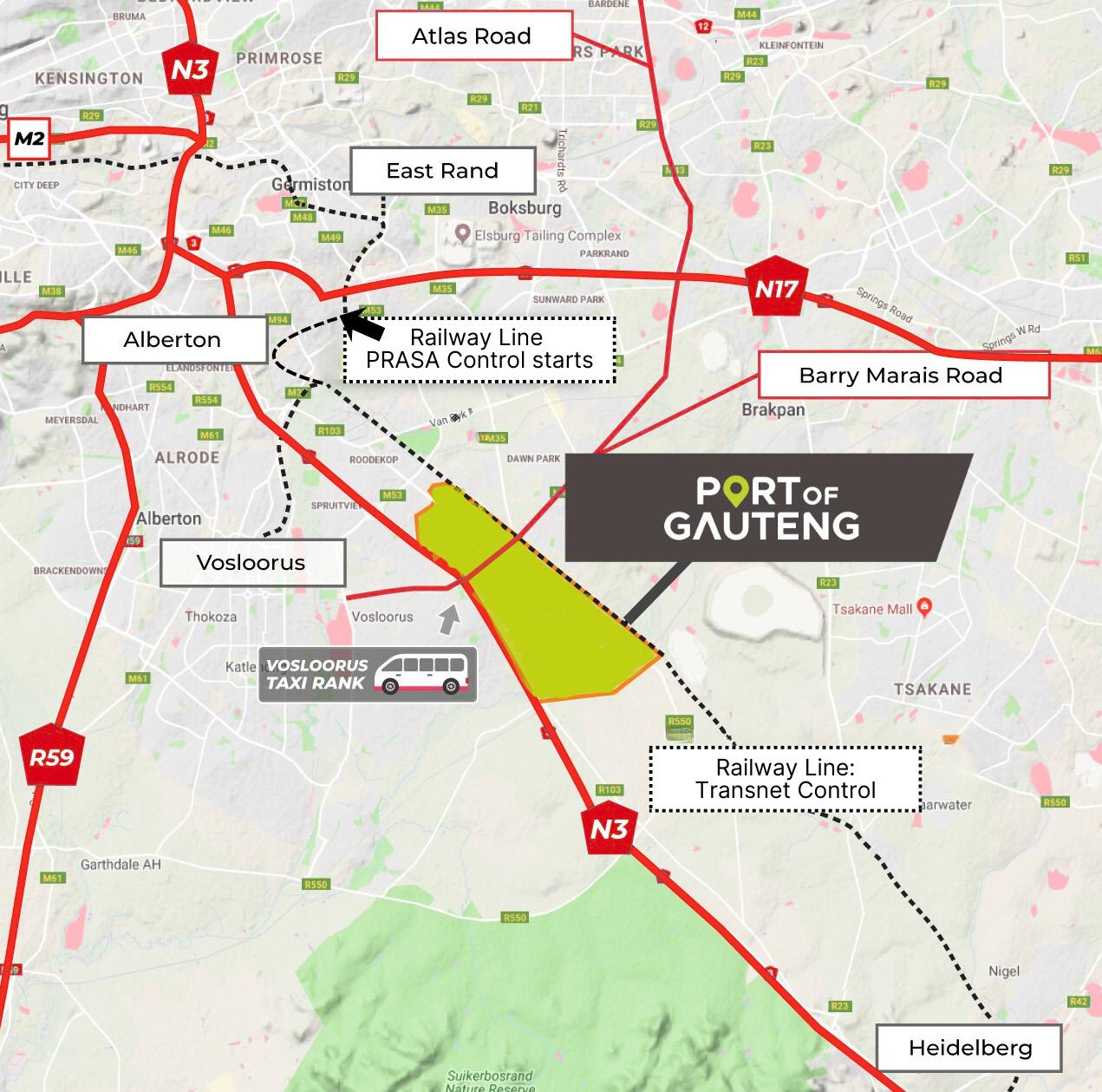
BY KOKETSO MAMABOLO
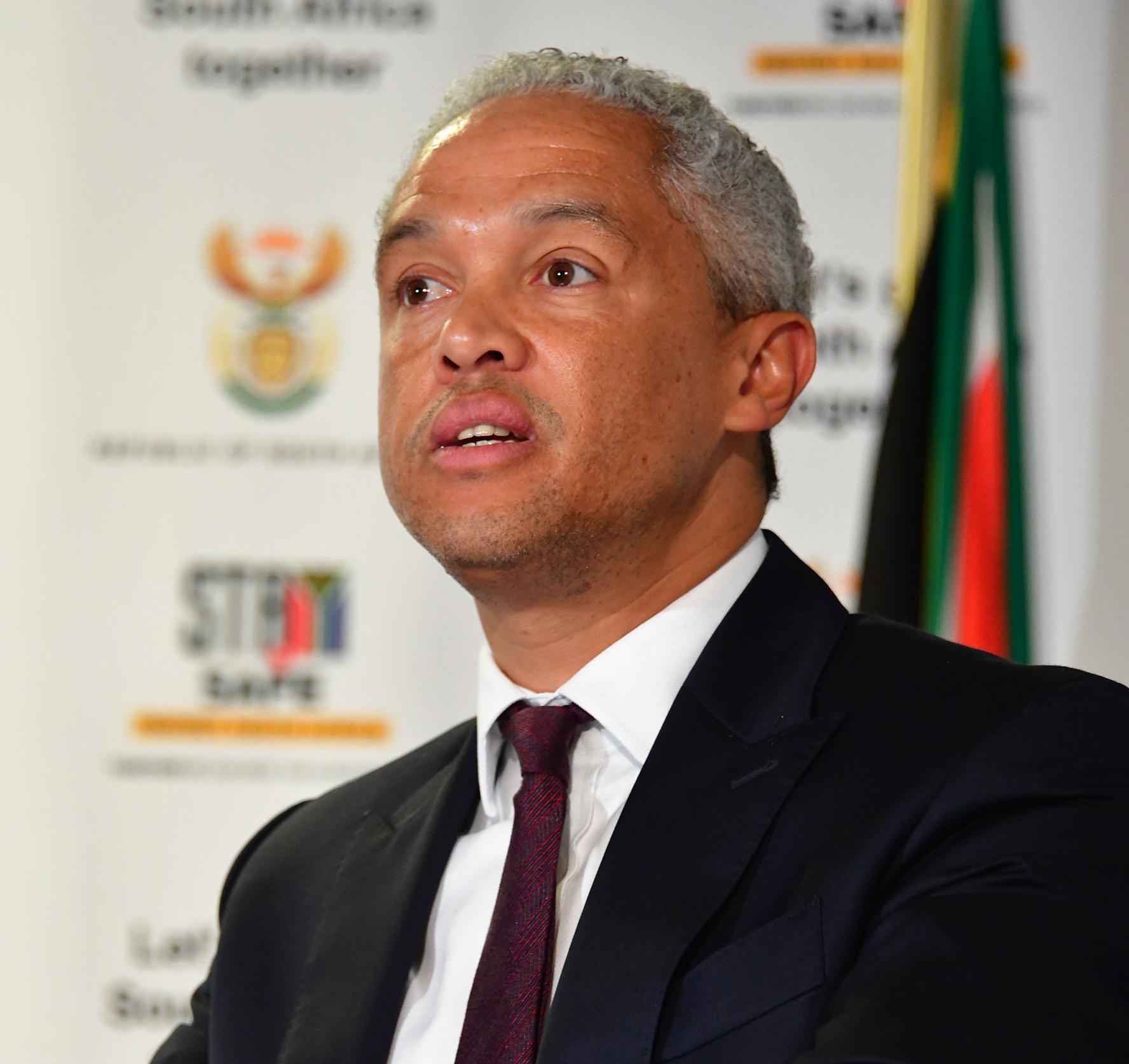
Treasury Director-General, Duncan Pieterse, at a Operation Vulindlela press conference
In the next couple years South Africa will join countries like Estonia, Brazil, and India in rolling out massive digital public infrastructure which will make a material difference for citizens. As part of the MyMzansi initiative, National Treasury recently launched the pilot of the MzansiXchange platform, a connected data ecosystem which will provide intra-
governmental data sharing for service delivery, planning, policymaking, and reporting. MyMzansi is a roadmap for the government’s digital transformation journey as part of Operation Vulindlela Phase II. Driven by the Presidency, Department of Communications and Digital Technologies, alongside National Treasury, the MyMzansi approach is
influenced by examples of digital public infrastructure around the world.
Savings galore
The focus for phase one of the MyMzansi initiative, which will run until 2027, is on “social protection, digital identity, and unified digital channels.” Pilot programmes for government payment
and service integration projects and a digital ID system are underway, along with the digital exchange ecosystem, and the initiatives will be scaled up from 2028 across government services such as healthcare and education.
The idea is to integrate data and make it more accessible for the good of the public, consolidating the fragmented data landscape. It has four pillars:
1. Data sharing for regulation, compliance, and verification
2. Data sharing for evidencebased policy, planning, and research
3. Data sharing for operational analytics
4. Open (public) access for sharing
MzansiXchange began as the South African Data Lake (SA-IDL) and builds on two initiatives.
The first is the National Treasury Secure Data Facility (NT-SDF), a collaboration between National Treasury, SARS, and the United Nations University World Institute for Development Economics under the SA-TIED programme.
The second is the Spatial Economic Activity Data South Africa initiative which has given local and provincial government access to anonymised tax data as part of National Treasury’s Cities Support Programme.
MzansiXchange builds on from the work already done by creating one platform for all services, providing personalised support and allowing for citizens to enter their data only
Source: National Treasury | MyMzansi
once, speeding up future processes. Through their own data exchange platform, Estonia was able to save on over 1 300 years of work time. Brazil saved billions of rands.
“Globally, data has moved from being used administratively to being considered a strategic asset and a key part of digital infrastructure,” said National Treasury’s DirectorGeneral, Duncan Pieterse at the pilot launch. “Just as road, electricity, and water infrastructure drive development, data is the backbone of digital transformation and inclusive service delivery.”
In his address at the launch, Pieterse cited four main benefits of MzansiXchange:
1. Improved service delivery and reduction in delays by streamlining administrative processes
2. Secure, easy access to data between departments
3. Elimination of redundant systems and the enablement of fraud detection
4. Informed planning and decision -making through access to data
Pieterse emphasised that MzansiXchange is not a central data repository. Data is not stored but shared through the system, blending the need for data sovereignty with the need to share information in a structured way.
“Our prototype has been built with X-road as the foundational technology for the MzansiXchange, supporting flexible mechanisms and enhancing resilience with
robust design, ensuring standards, harmonisation, digital inclusion and long-term sustainability,” explained Pieterse.
The technical architecture, both the hardware and software, is lean and scalable, say the project coordinators. By design it can be implemented in areas low on resources, which is particularly important given the large number of people living in rural districts.
Data will be accessible via a central catalogue, shared securely using clear protocols with every transaction tracked for auditing purposes. Data can be shared in bulk, in real-time, and in nonreal-time.
The 12-month pilot programme will be driven by four task teams covering legal & governance matters, technical aspects, organisational readiness & integration, and standards.
“This one-year pilot will test the MzansiXchange in real-world conditions, strengthening the foundations for a broader national roll-out.”
Duncan Pieterse concluded the launch by highlighting the underlying motive for the initiative which is trust:
“While today’s focus is on MzansiXchange, this is ultimately a whole-of-government effort. To succeed, we must build trust – trust between departments, trust in the system, and most importantly, trust with the public.”
WINDABA RECAP
BY JESSIE TAYLOR

The recent 14th edition of WINDaba - the flagship annual gathering of the South African Wind Energy Association (SAWEA) - marked a turning point for South Africa’s wind-energy sector by bringing urgent attention to grid constraints, investment readiness and industrialisation opportunities. The agenda arrived at a crucial juncture. The country’s Draft Integrated Resource Plan (IRP) envisions approximately 44.7 GW of new wind capacity by 2042, with about 34 GW allocated by 2039 and up to 8 GW expected from offshore developments by 2040. With 33 GW + of wind capacity already in the pipeline and roughly 2.6 GW under construction, the discourse moved from “what we want” to “how we make it real”.
South Africa’s wind energy landscape has evolved into one of the most dynamic and promising sectors within the country’s renewable energy portfolio. Since the launch of the Renewable Energy Independent Power Producer Procurement Programme (REIPPPP) in 2011, wind power has moved from pilot-scale projects to a critical component of national energy
planning. Today, more than 30 operational wind farms supply over 3.4 GW of installed capacity to the grid, with an additional 2.6 GW under construction and more than 33 GW in the project pipeline.
The sector’s momentum is driven by South Africa’s world-class wind resources, particularly across the Eastern, Northern, and Western Cape provinces, where average wind speeds make projects both technically and financially viable. Costs have also dropped significantly, with levelised tariffs now among the lowest of all generation technologies procured under REIPPPP. Beyond power generation, the industry supports local economic development, contributing an estimated R40 billion to GDP and creating thousands of jobs in construction, operations, and maintenance.
WINDaba 2025 drew a diverse array of stakeholders, including government ministers, regulatory authorities, financiers, developers, manufacturers, labour-market
representatives, and civil-society voices. The presence of Minister of Electricity and Energy Kgosientsho Ramokgopa as patron and keynote speaker underscored the political will behind the energy transition.
Key issues raised included unlocking grid-access bottlenecks, accelerating procurement cycles, enabling investor confidence mechanisms, and advancing the localisation of manufacturing and skills development. Delegates learned that the wind-energy project pipeline has grown to 50 GW+, up nearly 60 % since 2023.
The theme placed grid reform front and centre, acknowledging that wind farms alone will not deliver unless transmission and grid connectivity infrastructures keep pace. One of the most consistent messages at the conference was that transmission and grid access remain the greatest barrier to scaling wind energy in South Africa. Even with a strong project pipeline, capacity without connectivity becomes stranded.
The 2024 South African Renewable Energy Grid Survey (SAREGS) pointed to this risk. The takeaway was clear: if the grid remains the bottleneck, the megawatts won’t flow. But if grid reform is prioritised, South Africa can convert a massive pipeline into tangible generation and industry growth.
Beyond megawatts: localisation, industry and jobs
WINDaba’s outlook was holistic: it emphasised that wind-energy growth is not simply about renewable capacity numbers, but about economic transformation, industrial development, and inclusive growth. Panels stressed that decisions now will determine whether the sector delivers broadbased benefits or remains narrowly focused. The concept of a “peoplecentred transition” was underscored, encompassing not just new projects, but also skills development, supplychain development, community participation, and localisation. WINDaba also placed heavy emphasis on investment flows
and procurement certainty. With policy signals improving, the event highlighted that South Africa needs to translate investor interest into actual deals. Developers noted that procurement windows must be clear, rationalised, and supported by efficient grid integration.
At the same time, value-chain readiness-encompassing everything from manufacturing to logistics to servicing-must scale. Wind-energy sector stakeholders emphasised that now is the time to build domestic capability rather than simply import components. This aligns with the government’s push to integrate renewables with industrial policy and local goods manufacturing. The momentum emerging from WINDaba signals that delays now may translate into lost opportunities. Public-sector entities must position themselves as enablers of growth, not bottlenecks. WINDaba 2025 closed on an encouraging note. The messages emerging from Cape Town were not ones of caution, but of readiness - readiness to turn
Source: Farmers Weekly | Engineering | ESI-Africa | SA Business Integrator | SAWEA

wind energy potential into projects, jobs, and investments. The event reaffirmed that South Africa’s windenergy sector is at an inflexion point. With momentum behind it, the next 12 to 24 months may well determine whether the country realises its ambitious wind targets.
Yet the journey is far from complete. Grid constraints, procurement timetables, value-chain readiness, and finance access remain real challenges. But what distinguishes WINDaba 2025 is the shift from “if we try” to “when we deliver”. The tone was pragmatic and optimistic. The sector is aligned, the pipeline exists, the ambition is clear - now the focus is on execution.
WINDaba 2025 provides a blueprint for scaling renewables strategically across technical, economic, and social dimensions. As South Africa prepares for growth, the wind sector is ready - the question now is how fast and how inclusively we can turn that readiness into reality.
BY JESSIE TAYLOR

The Integrated Resource Plan 2025 (IRP 2025), approved by South Africa’s Cabinet in October, represents a transformative blueprint for the country’s electricity sector, setting the stage for investment, industrial development and a cleaner, more reliable energy future
Among its most noteworthy aspects is a strong focus on nuclear power and a nuclear industrialisation agenda, signalling that atomic energy is no longer an aside, but a core pillar in South Africa’s drive to secure its energy supply, stimulate domestic industry, and bolster long-term economic growth. South Africa holds a unique position on the African continent as the only nation
with an operational nuclear power station located in Cape Town, which has been supplying clean, reliable energy to the grid since 1984.
The country’s nuclear capabilities extend beyond power generation, with strong research, regulatory, and training frameworks led by the South African Nuclear Energy Corporation (Necsa). South Africa also operates the SAFARI-1 research reactor at Pelindaba, one of the world’s leading producers of medical isotopes.
A bold energy roadmap
According to the Department of Electricity & Energy and the IRP documentation, the plan calls for more than 105 000 MW of new
generation capacity by 2039. It maps out a total investment of approximately R2.23trillion. Within this, the nuclear component stands out: the plan allocates 5 200 MW of new nuclear capacity by 2039, with the possibility of increasing up to 10 000 MW.
Importantly, the IRP emphasises that nuclear isn’t simply about electricity generation - it is a driver of industrialisation, localisation and technologysupporting sectors. As the IRP overview notes, nuclear is “a dispatchable, low-carbon option capable of providing the large-scale, stable power
needed to support South Africa’s transformation agenda”. The new IRP incorporates a comprehensive nuclear industrialisation plan. According to the South African Nuclear Energy Corporation (Necsa), the nuclear allocation creates an opportunity to regenerate the domestic nuclear fuel cycle, develop small modular reactors (SMRs), and rebuild skills and manufacturing capabilities in South Africa.
Minister Kgosientsho Ramokgopa emphasised that the value of nuclear extends to the localisation of components, valuechain development, and export opportunities.
“It’s not just converting nuclear into electricity. It’s about what benefits the South African economy and which parts of the fuel cycle we can domesticate or localise,” he said.
Specific elements include reviving the country’s Pebble Bed Modular Reactor (PBMR) programme, refocusing on SMRs, and rehabilitating supply-chain capacity for nuclearengineering work.
In a context where South Africa continues to grapple with load shedding, frequent power outages, and ageing coal infrastructure, the IRP’s recognition of nuclear as both a clean and reliable baseload option is significant. The plan acknowledges that while renewables, such as wind and solar, are pivotal, they must be paired with firm, dispatchable sources to ensure stability,
especially as the grid evolves. From an industrial standpoint, nuclear brings jobs, skills and manufacturing opportunities that go beyond what intermittent renewables can deliver. The localisation of reactors, fuelcycle elements and supporting industries offers a meaningful stimulus to manufacturing, engineering training and export ambitions. The nuclear build also sends a powerful message to investors: South Africa is serious about large-scale infrastructure and long-term industrial strategy.
As with any plan of this scale, the real test lies in execution. The IRP recognises several hurdles: rebuilding engineering and construction capacity (given the decline of domestic large civil engineering firms), enhancing the national skills pipeline, and ensuring procurement and grid integration readiness.
The plan invites greater collaboration with the private sector: South Africa’s nuclear ambition will depend on partnerships with global technology providers, EPC contractors, financing institutions and local suppliers. For municipalities and regional government, the decentralised nature of many future reactors
and SMR deployments means that local readiness, community engagement, and infrastructure readiness will play a significant role.
The approval of the IRP 2025 is more than a policy update - it marks a shift in mindset. It signals that South Africa is moving from crisis management of its electricity supply to strategic, long-term energy infrastructure planning. The placement of nuclear at the core of that strategy is bold, but clearly rooted in industrial and developmental logic as much as energy logic.
By investing in nuclear industrialisation, South Africa positions itself not only to meet its own energy needs but to become a regional manufacturing hub for next-generation nuclear technology in Africa. The fusion of energy security, economic development and global competitiveness is tangible in the IRP. As the first reactors are planned and localisation efforts begin, public-sector leaders have a unique opportunity to shape an energy economy that works for jobs, industry, and the
Source:

BY WANDILE SIHLOBO

On October 21, 2025, on the sidelines of the Financial Times
Africa Summit in London, I sat with the CNBC folks for a broad conversation about South Africa and the southern African agricultural developments and trade. On trade matters, I highlighted that for its export diversification strategy, South Africa is looking at broadening exports to Asia and the Middle East. The natural and fair question that followed was: What is our strategy for Africa?
The African continent remains vital to South Africa's agriculture, accounting for roughly half of our annual exports. We exported about US$13.7-billion to the world market in 2024, and I suspect this year our
agricultural exports will cross the US$14-billion mark for the first time.
Africa has been central to this export growth, particularly the southern Africa region. I have said here before that roughly 90 cents in every dollar of South Africa's agricultural exports to the African continent are to the countries in the southern African region. These are mainly in the Southern Africa Customs Union (SACU) and the Southern African Development Community (SADC) Free Trade Area (FTA). We will likely remain heavily dominant in these regions for some time, but the growth is limited. We are not as strong in other parts of the continent as we are in the southern Africa region. I also
do not view the rest of the region as particularly exciting as new markets.
The product scope of agricultural exports into SACU and SADC is quite diverse. It includes maize, processed food products, apples and pears, sugar, animal feed products, prepared or bottled water, fruit juices, and wine.
The question is, just how much more can South Africa export beyond the SACU/SADC region, and what is our attitude towards greater Africa? The most reasonable assumption is for South Africa to target west, east, and north Africa. But such an expansion has limits.
For a start, Africa north of the Sahara, more specifically the Maghreb region (i.e., Algeria, Libya, Mauritania, Morocco and Tunisia), is much closer to Europe, and its trade activity is more closely linked to the EU rather than sub-Saharan Africa.
In addition, South Africa competes with this region in several products, aiming to increase its exports, primarily high-value horticulture products. Establishing a market presence in north Africa may prove challenging due to direct competition with well-established EU supply chains and competitive local produce.
South Africa's realistic opportunity within the African continent is more likely in east and west Africa. Leveraging the African Continental Free Trade Area (AfCFTA)'s tarifffree movement of goods would potentially boost the country's agricultural exports to these regions. But, at least in the near term, trade with these regions may not yield many benefits for South Africa.
There are at least three reasons why not: East and west African regions have a range of non-tariff barriers, which could hinder boosting trade regardless of lower tariffs brought by the AfCFTA; secondly, high levels of corruption, which increase the costs of doing business, have proven to
be a significant business concern; and thirdly, fragmented value chains owing to poor connectivity and infrastructure are also a major contributor to transport costs, which tend to increase significantly as goods are transported inland.
This narrow scope of expanding agricultural exports in the African continent typically leads to frustration among business leaders, who continue to see improvement in domestic production but are limited in avenues for sales. The major economies in the east and west of the continent, Nigeria and Kenya, remain tiny markets for South Africa's agricultural exports, each accounting for a mere 2% a year.
Still, Nigeria spends over US$6-billion on agricultural imports a year. The key beneficiaries of the Nigerian agriculture market are Brazil, the US, China, Russia, Canada, New Zealand, and Germany. This is through imports of wheat, dairy products, sugar, processed food, palm oil, and maize, among other products.
Meanwhile, Kenya is a relatively small market with just over US$2billion worth of agriculture and food imports a year. The key suppliers are Indonesia, Malaysia, Argentina, Russia, Pakistan, Uganda, Tanzania, India, and Egypt. Kenya's key agriculture and food imports

are palm oil, wheat, rice, sugar, processed food, maize, dairy products, pasta, and sorghum, among others.
Therefore, indeed, South Africa will play a more maintenance approach rather than hoping for further expansion in the African continent. The near-term growth areas in our assessment are the Middle East and Asian countries. The growing population and better income levels in these regions are among the key indicators we observe.
Therefore, when one reads that South African leaders are in Asia, visiting countries such as Vietnam, China, Malaysia, and India, among others, it is important to consider the implications. Also, when our leaders are in the Middle East, meeting with stakeholders in the Kingdom of Saudi Arabia, Qatar, and the UAE, among others, the core conversation should focus on this export diversification approach, among other things. I have outlined an agricultural approach here, but this should serve as a path for all our export-oriented sectors of the economy.
Wandile Sihlobo is the chief economist at the Agricultural Business Chamber of SA (Agbiz) and a senior fellow in Stellenbosch University’s Department of Agricultural Economics.


BY JESSIE TAYLOR
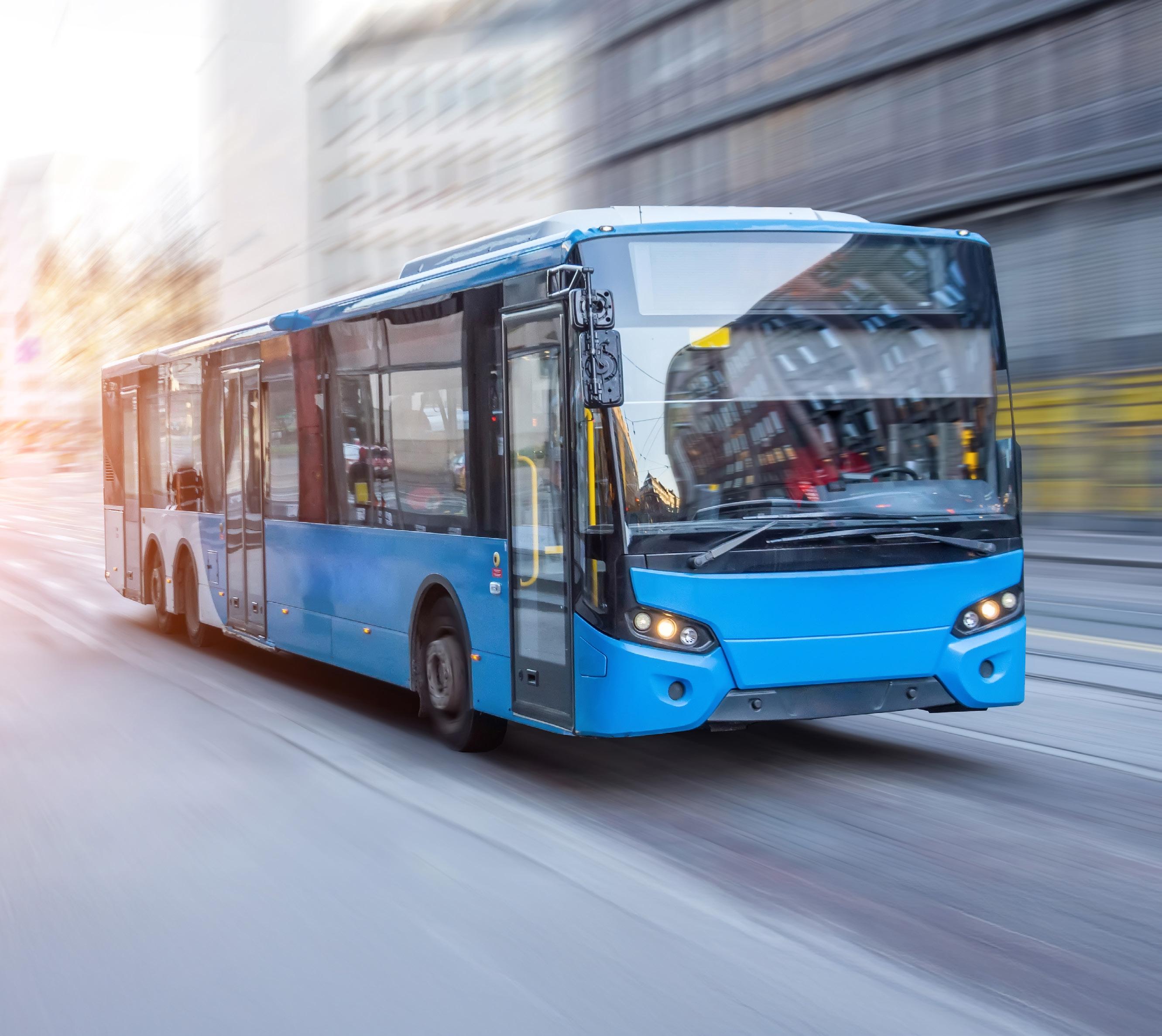
ape Town’s bus-rapid transit system, MyCiTi, has been steadily evolving into a hallmark of modern, accessible, and inclusive public transport - and its next major leap is digital. The recent announcement that MyCiTi will adopt a “swipe-free” payment system marks a significant milestone in the City of Cape Town’s ambition to streamline commuting and enhance the system’s convenience for all passengers.
Launched in May 2010, MyCiTi was conceived to plug the gap between high-capacity public rail and informal minibus-taxi services, offering a more structured and accessible network. Over the years, the network has expanded considerably, now connecting suburbs, townships, and the Cape Town central business district (CBD), with dedicated bus lanes, modern
stations, and a commitment to affordability, safety, and reliability.
Digital innovation in line with international best practices
Effectiveness has been evident in the ridership figures. For example, the 12 months from July 2022 to June 2023 saw 18.32 million passenger trips-an increase of up to 68% year-overyear since 2021. In March 2024 alone,
1.655 million journeys were recorded, averaging over 64,000 weekday trips-another clear sign of rising demand. These numbers reflect MyCiTi’s growing role in mobilising commuters, reducing privatevehicle dependency and easing traffic congestion.
The digital initiative now underway is timely and strategic. With the roll-out of account-based ticketing (ABT), passengers will soon be able to use smartphones, smartwatches or contactless bank cards to board, doing away with the traditional reloadable MyCiTi card. This shift is particularly beneficial for tourists, occasional users and commuters who may otherwise face friction in accessing the network. Moreover, it helps the system align with global best practices in transit payment and subscription services.
Another compelling advantage of MyCiTi is its dedicated infrastructure: on many routes the buses run in red-marked lanes or priority corridors, reducing travel-time delays associated with mixed traffic. Officials note that this reliability is a key attraction, especially when rising fuel prices make car use more expensive. By contributing
to more predictable commuting, MyCiTi supports both productivity and quality of life for Cape Town’s residents. MyCiTi is also part of a broader social and spatial justice agenda. Cape Town’s legacy of apartheid spatial planning relies heavily on transport interventions to link outlying communities to opportunities in the city. MyCiTi’s expansion into townships such as Khayelitsha and Mitchells Plain via the N2 Express routes has been an essential component of that strategy. By providing affordable, scheduled, and safe transportation, the system enhances access to jobs, education, and services.
A data-first approach
The system’s digital transformation goes beyond payment convenience - it’s about building an intelligent mobility network. Data from the MyCiTi app and automated fare collection systems help the City of Cape Town analyse commuter behaviour, identify congestion points, and plan for future expansion. Real-time analytics enable officials to adjust services dynamically, especially during peak hours or special events. For passengers, the benefits are equally tangible. The ability to manage travel through a
smartphone app, including checking live bus arrivals, route updates, and fare balances, translates to greater autonomy and reduced waiting times. The app already enjoys widespread adoption, particularly among younger commuters and tourists, and the upcoming ABT integration will make digital travel management even more seamless.
Looking ahead, MyCiTi’s digital transformation is well-aligned with global trends in public transport, namely integrated ticketing systems, real-time journey management, and contactless payment, coupled with intelligent route planning. The “swipe-free” future reflects a modern Cape Town - one that embraces technology to drive accessibility, sustainability, and inclusion.
MyCiTi is not just an urbanmobility project-it is a catalyst for transformation, digital innovation and enhanced commuter experience in Cape Town. The system’s steadily growing ridership, infrastructure expansion and upcoming digital payment capabilities position it well to meet the evolving needs of the city’s residents and visitors alike.
• 18.32 million passenger trips recorded in the 12 months from July 2022 to June 2023 – a 68 % increase compared with 2021.
• March 2024: 1 655 882 passenger journeys, with an average of 64 094 weekday trips.
• Since launch in 2010 until December 2021: approximately 134 million passenger trips.
• Network covers ±45 routes, spanning central Cape Town, the Atlantic Seaboard, Table View, Dunoon, Atlantis, Hout Bay, Mitchells Plain and Khayelitsha.
• The official MyCiTi mobile app offers journey planning, real-time updates, favourites functionality and balance checking.
• MyCiTi aims to expand into the metro-south east as part of the City’s long-term Integrated Public Transport Network plan.
REGIONAL FOCUS - NORTH WEST
BY JESSIE TAYLOR

From maise fields and livestock farms to emerging agri-hubs and digital databases, the North West is steadily repositioning its agricultural sector as an engine of growth, food security, and rural empowerment. Anchored by a growing provincial budget, innovative partnerships and infrastructure-led upliftment, local government and academia are working together to unlock the province’s agricultural potential.
Growing investment and bold new platforms
Recent provincial budget data show that the Department of Agriculture and Rural Development (DARD) for the North West has increased its overall budget for agriculture, signalling renewed commitment to supporting production, distribution and transformation. The increase is a welcome step, particularly given the importance of agriculture in the province’s economy and in job creation.
One of the most visible innovations has been the launch of an agri-hub in partnership between the regional government and North-West University (NWU) at Mahikeng. This facility is designed to serve as a modern centre for farmer training, processing, logistics, storage and market access - a onestop point for emerging and commercial producers alike. The hub is positioned to strengthen the province’s competitiveness in domestic
and export markets, while helping smallholders scale up their operations.
Parallel to infrastructure, digital systems are gaining traction. The provincial farmer database initiative is being promoted across the North West - with DARD urging all farmers to register their enterprises. This centralised database enables better planning, grant allocation, market linkages and oversight. When combined with improved extension services - such as a conference in May 2025 that upskilled over 150 stakeholders in digital and on-farm tools - the foundations for a more resilient and data-driven sector are being laid.
Importantly, the funding is not only going to big commercial farms. DARD recently announced a R252 million programme to support more than 1 900 smallholder and emerging farmers. These funds are targeted at inputs, mechanisation, training and infrastructure support - a clear signal that inclusivity is core to the provincial vision. Within this package, specific allocations such as over R36 million to the redmeat industry testify to the strategic focus on value-chain development and targeted intervention.
While the momentum is promising, there are still challenges. Notably, while overall budget allocations
have increased, funding for research and technology development services in the province’s agriculture department has dropped by around 23% compared to the previous year. In an era when digital tools, AIdriven analytics and precision agriculture are rapidly becoming key differentiators, this reduction prompts a call for renewed investment in innovation. Without it, the sector risks lagging behind global best practice and missing opportunities for productivity gains.
Another challenge lies in ensuring that infrastructure, extension services, and markets keep pace with the investment in support and funding. The success of the agri-hub, database and extension programmes will hinge on seamless coordination between multiple agencies, as well as the ability of farmers to access and adopt new tools and models. These are not trivial tasks, but the presence of committed leadership and strong partnership frameworks offers reason for optimism.
From a regional economic perspective, strengthening agriculture is a strategic lever for the North West. Agriculture contributes to job creation, rural livelihoods, food security and linkages with downstream processing and export sectors. By creating agrihubs, supporting smallholders, and digitising farmer databases, the province is building infrastructure not
Source: NWU News | South African Government | Food For Mzansi | SA News | DARD
only for production, but for transformation - from primary production to value-chain empowerment.
Over the coming years the North West Province is well placed to begin harvesting the benefits of its renewed agricultural strategy. With increased budget allocations, expanded farmer support, stronger training and infrastructure, the province can look to improve yields, deepen local value chains, and access export markets. This in turn can raise incomes, diversify rural livelihoods and reduce dependency on external employment.
Emerging farmers who previously lacked access to capital, markets or training are now being brought into the mainstream - and as they scale, the province’s agricultural profile strengthens. Meanwhile, established commercial farmers are gaining tools, infrastructure and collaborative platforms tailored to modern demands.
The agri-hub in particular can act as a bridge between these categories, facilitating knowledge transfer and market access. The North West’s agricultural sector is entering a phase of constructive transformation. By combining increased funding, infrastructure such as agrihubs, empowering smallholder programmes, digital databases and extension services, the region is taking concrete steps to raise productivity, inclusivity and
SPORTING ACTION
BY KOKETSO MAMABOLO
When the final wicket fell at DY Patil Stadium, between the shots of the light blue sea of celebrating fans, cameras fell onto the forlorn figure of the losing team’s captain, Laura Wolvaardt.
She tried her best. In the biggest moment of her life she gave everything. But in sport, as in life, you can give everything and get nothing in return. The Proteas skipper had led her team to the Women’s ODI Cricket World Cup final for the first time in the country’s history and breezed through playoffs with performances that may come to define her career. And yet, the glory belongs to Harmanpreet Kaur and her side.
When India and South Africa took the field, both were out to make history. For over 50 years the spoils have gone to two countries. Of the thirteen tournaments since 1973, seven have been won by Australia, and four by England. In Navi Mumbai, either captain could’ve emulated Emily Drumm and her victorious White Ferns, who had briefly broken the Anglo-Australian monopoly, right at the start of new millennium.


Proteas Women leave India still on the chase
The rain delayed the toss by two hours, and one day sports historians may debate whether or not it was the right choice for the Proteas to l et India bat first. Maybe the decision was predetermined, maybe the one hundred and twenty minutes of waiting and factoring in the rain muddied the waters but in the end the result was India setting up a respectable 298 - 7. It didn’t take long for Shafali Verma and Deepti Sharma to make a home for themselves at the crease, facing little challenge from the Proteas bowlers. Ayabonga Khaka was the best of the lot, putting up a commendable performance with the ball and finishing with similar figures to India's best bowler on the day, Deepti Sharma.
On another day maybe it wouldn’t have been too much but two dropped catches and disappointing performances with the bat made the target of 299 a tall order.
in the past, Laura and her team’s performances in the tournament, minus the atrocious first game against England, meant that no-one could count them out. That was until Woolvaardt’s wicket fell after 101 runs off 98 balls, and fans were left reeling for the rest of the match.
Her final knock took her to 571 runs, making her not only the tournament's highest run-scorer but the new record holder for runs total at a single World Cup. Her back-to-back centuries in the semi-final and final were a World Cup first, including a 169 off 143 against the same England side that had stunned the Proteas by bowling them all out for 69.
She reached 5 000 ODI runs at the World Cup, becoming just the sixth player in women’s ODI history to do so. Laura is the youngest South African, man or woman, to score an ODI century. She was just 17 when she announced her arrival, roughly three years and 200 days younger than Quinton de Kock when he broke the record three years prior. It’s no
and continues to prove it. And if that’s not enough, the opener known for her brilliant cover drive is only 26. It says a lot, she admits, that it hasn’t even been her best year.
And in this light, Laura did not leave with nothing. She left with pride, records, and hope that after one ODI and two T20 finals lost in a row, despite a domestic system which many flounder in, there is silverware and not just silver medals in the future of women’s cricket in South Africa.
While stalwart Marizanne Kapp, a local legend, could not cap-off an inspiring career with a World Cup win, she will one day leave the team in good hands, and with the satisfaction of knowing it will be some time until someone can attempt to challenge her status as the leading wicket-taker in women’s ODI history. She will join the great pantheon of the oval field magicians, with the Kallis’ of the world. Laura and co are not far behind.


BY JESSIE TAYLOR

In South Africa, the push to expand solar energy is not simply about cutting power bills or reducing load-shedding - it has become a compelling financial opportunity. Thanks to recently enhanced tax incentives, businesses and individuals alike are tapping into a dual benefit: generating cleaner electricity and unlocking tax savings while contributing to long-term economic resilience.
For commercial enterprises, the key driver has been Section 12B of the Income Tax Act (and the now-expired enhanced allowance under Section 12BA). These provisions allow businesses to deduct 100% (and formerly up to 125%) of the cost of eligible solar renewable-energy assets in the year of commissioning. As a result, investment in commercial solar projects has soared, with estimates indicating over R1-billion has been deployed in fewer than two years, financing more than 250 commercial projects totalling some 48 MW of capacity.
For individuals, the incentives are more modest, but still impactful. A tax rebate of up to 25% of the cost of new and unused solar PV panels (with a cap of R15 000) was introduced for installations at primary residences, provided that compliance conditions are met. While this credit is capped and time-limited, it lays the groundwork for broader household adoption and helps shift perceptions of solar from a premium niche to a mainstream option.
Several factors are combining to make this a particularly favourable time for solar investment in South Africa: the cost of panels has dropped significantly (industry sources suggest up to a 50% reduction over five years) and payback periods are now often between three and six years for commercial systems, depending on size and configuration.
Meanwhile, recent policy and regulatory changes have significantly reduced compliance costs: new rules have lowered compliance expenses to as little as R1500 for smaller installations.
The tax incentives don’t occur in isolation; they form part of a broader shift in South Africa’s energy economy. Through programmes such as the Renewable Energy Independent Power Producer Procurement Programme (REIPPPP), the nation continues to attract privatesector capital into utility-scale solar and wind assets, with recent data indicating R64.8billion of energy investment. In this context, the solar tax incentives help embed smallerscale private investment into the energy transition and bolster the country’s climate-aligned growth narrative.
Solar’s
For businesses, the 100% deduction under Section 12B materially improves the return on investment for solar installations. If a company invests R1-million in a qualifying system, the immediate tax deduction
significantly reduces taxable income, improving cash flow and lowering the overall cost of energy. Because many companies face steep electricity tariffs (and unpredictability due to grid instability), the ability to switch to solar becomes both a costmanagement and risk-mitigation strategy. South Africa’s solar tax incentives represent a potent financial lever: they reduce upfront cost, improve returns and align energy investment with broader national transition goals. As the country steps into this next phase of its energy transformation, those who act now are likely to benefit most - from tax relief, energy savings, and the strategic tailwind of a reform-driven investment landscape.
Beyond its energy impact, the surge in solar adoption is fuelling new opportunities in manufacturing, installation, and maintenance services. The South African Photovoltaic Industry Association reports that the renewable-energy value chain now supports more than 66 000 jobs nationally, with a large portion tied to small and medium-sized enterprises that install or service systems.
Local content requirements and demand for solar components have also sparked investment in panel assembly plants, inverter testing facilities, and innovations in battery storage. Analysts forecast that the solar economy could add R40-billion annually to GDP by 2030, provided regulatory and fiscal incentives remain stable.
According to data from the South African Photovoltaic Industry Association, the country added approximately 1.1 GW of new solar capacity in 2024, following a record 2.6 GW in 2023. This made South Africa the continent’s leader in solar installations for the second consecutive year.
The private sector has been the driving force behind this growth. As of mid-2025, rooftop solar capacity, mostly from commercial and residential users, exceeded 7 300 MW, a remarkable increase from just under 1 000 MW in early 2022. In total, private generation now accounts for nearly half of South Africa’s installed solar power base.
Treasury data suggest that more than 100 000 households applied for solar-related rebates during the Household Solar Rebate Programme, introduced in 2023, collectively investing over R4 billion in rooftop PV systems. The commercial and industrial sector has seen over R16 billion channelled into large-scale rooftop and embedded generation projects since the tax incentive took effect.
BY JESSIE TAYLOR

For years, South Africa’s labour laws have reflected an outdated idea of family roles, offering extensive maternity leave to mothers while granting fathers and other parents just a handful of days. That imbalance is now changing, thanks to a landmark ruling by the Constitutional Court.
The court has redefined the framework of parental leave, affirming that all parents -
regardless of gender, biological connection, or family structure - deserve equal time to nurture and bond with their children. The judgment, delivered in October, represents a significant step toward gender equality and inclusivity in the workplace.
This decision not only modernises the interpretation of family in South African law but also challenges employers to adopt more equitable parental leave policies.
It’s a progressive moment for families and workplaces alike-one that acknowledges the evolving ways in which South Africans build, raise, and support their families.
At the heart of this shift is the Constitutional Court’s finding that the Basic Conditions of Employment Act (BCEA) and the Unemployment Insurance Fund (UIF) Act were

inconsistent with the Constitution because they unfairly discriminated against parents based on gender and family structure. Previously, the BCEA granted mothers four months of maternity leave, while fathers or partners were entitled to just 10 days of parental leave.
Now, that system has been overhauled. The Court has ruled that both parents are entitled to share four consecutive months of parental
leave, allowing them to decide who will take on the primary caregiving role. The partner not taking the bulk of the leave will be entitled to at least 10 consecutive days of leave. This approach reflects the modern understanding that caregiving responsibilities should not fall disproportionately on one parent.
The judgment emphasised that the law must accommodate all families, including adoptive parents, same-sex couples, and surrogacy arrangements, on an equal footing. Employers, therefore, need to review their leave policies to ensure they align with the new constitutional standard.
The ruling recognises that parenting is not just about biology - it’s about commitment, care, and shared responsibility. By enabling both parents to take leave, the Court promotes a more balanced family dynamic, one in which fathers and partners can play an active role from the very beginning of a child’s life.
Beyond its legal implications, this change could also have far-reaching social and economic benefits. Research consistently shows that children thrive when both parents are actively involved in early development. Similarly, when men take parental leave, women are more likely to return to work, pursue leadership roles, and earn equitable pay.
What this means for employers
For employers, the ruling brings both challenges and opportunities. HR departments will need to update employment contracts, company policies, and benefit structures to comply with the new framework. The Department of Employment
and Labour is expected to issue updated guidelines; in the meantime, organisations are advised to review their policies proactively.
Employers are encouraged to treat all parental leave applications with fairness and consistency, regardless of an employee’s gender or the type of family arrangement. Those covered by the UIF should also note that claims will need to reflect the new shared leave system.
The broader message is clear: flexible, inclusive workplace policies are not only a matter of compliance-they are key to attracting and retaining top talent. Companies that support work-life balance and recognise diverse family structures stand to benefit from higher employee engagement and stronger organisational culture.
While the Court’s ruling sets a new legal precedent, its practical implementation will take time. Employers must adjust HR systems, payroll structures, and benefit schemes to accommodate shared parental leave. Similarly, the UIF will need to modify its administrative processes to support dual-parent claims.
However, the long-term benefits are clear: a more compassionate, equitable, and productive workforce. By promoting gender equality and shared parenting, South Africa is laying the groundwork for a stronger, more inclusive societyone where family and work coexist in harmony rather than conflict.
This is more than a legal reform; it’s a cultural shift. And as South Africans begin to experience its impact, workplaces across the country have an opportunity to lead by example, turning constitutional ideals into everyday practice.
BY LISA FIRER
Many people working in offices live from the neck up! Long hours on screens, back-to-back meetings, constant emails and messages — our bodies often end up stiff, tired, and forgotten. Shoulders creep up, jaws clench, backs ache, and stress quietly hums in the background.
Clinical Somatics, also known as Hanna Somatics offers a simple but powerful way to change that. It’s a gentle movement practice that helps us become more aware of where we’re holding tension and teaches the body how to release it. The result? Less pain, more energy, and a clearer, calmer mind — something everyone in the corporate world could use a little more of.
What exactly is Hanna Somatics? Developed by Thomas Hanna in the 1970s, this approach is based on a simple idea: our brains can
“forget” how to relax certain muscles. This happens through Sensory-Motor Amnesia — a kind of autopilot pattern where muscles stay tight long after the original stress or strain is gone.
For example, think of hunching over a laptop all day. Even when you finally close it, your shoulders might stay rounded, your chest collapsed. You don’t consciously choose that posture — your brain just keeps repeating it.
Hanna Somatics uses a technique called pandiculation (think of that natural yawn-and-stretch movement you make when waking up) to “wake up” those forgotten muscles.
What’s Pandiculation — and why It matters
If you’ve ever watched a cat stretch after a nap, you’ve seen pandiculation in action. It’s that slow, satisfying whole-body yawn — a natural reset that every animal does many times a
day. Humans are born doing it too, but over years of stress, tension, and social conditioning (“sit still,” “don’t slouch,” “focus”) we gradually lose touch with this built-in mechanism.
Pandiculation is your nervous system’s way of recalibrating muscle tone and resetting how your brain senses and controls movement. It’s not a stretch in the way we usually think of stretching — there’s no pulling or forcing involved. Instead, it’s a three-step process:
1. Gently contract a muscle group that feels tight, on purpose.
2. Slowly release that contraction while paying close attention to the sensation.
3. Completely relax and notice the feeling of ease that follows.
That mindful release tells the brain, “You can let go now.” It’s like pressing “refresh” on the connection between your brain and body.

We often live with background tension — hunched shoulders, tight jaws, clenched bellies — and pandiculation is a quick, accessible way to unwind that pattern. It helps break the cycle of stress before it snowballs into pain or fatigue.
Unlike stretching, which works on the muscle itself, pandiculation works with the brain — the command center that controls the muscle. It’s a form of neuromuscular education: by consciously sensing, contracting, and releasing, you restore voluntary control where it was lost. That’s why the effects are often longer-lasting than a massage or quick stretch.
Let’s try: A short shoulder pandiculation
You can do this seated at your desk.
Begin with awareness.
Take a moment to pause. Notice how your shoulders feel right now. Are they lifted, rounded, tight? Just observe, without trying to change anything.
Gently contract.
Slowly lift your shoulders toward your ears — not as high as possible, just enough to feel the muscles in the tops of your shoulders gently engage. You might also pull the shoulders slightly forward or back — explore where you feel the tension lives.
Sense and release.
Now, very slowly, lower your shoulders down. Feel the muscles softening as you release. Let the movement be slower than you think it needs to be — that’s how your brain learns the difference between tension and ease. Don’t hold your breath as your release.
Completely relax.
When your shoulders settle, take a breath and notice the new sensations — warmth, openness, maybe a sense of lightness or space.
Repeat once or twice.
Pause, breathe, and notice your posture now. Many people find their chest feels more open and their head sits more naturally on the spine — a quiet reminder that even a minute of mindful movement can reset the system.
Why this matters in the corporate world
1. Relief from everyday aches and pains Many office workers live with lowgrade pain — tight shoulders, stiff necks, sore backs. These aren’t just annoyances; they affect focus, mood, and productivity. Hanna Somatics helps you discover how you’re creating that tension and gives you tools to undo it. As muscles relearn to let go, posture naturally improves, and discomfort eases.
2. Calming the stress cycle
Modern work often keeps the body in a subtle fight-or-flight mode — shallow breathing, clenched jaws, tight bellies. Somatic movements help shift the nervous system out of that constant alert state. As the body settles, the mind follows. Regular practice can make it easier to stay centered during high-pressure moments, meetings, or deadlines.
3. More focus and energy
When you’re tense, energy leaks into holding patterns you don’t even notice. By learning to move more freely, you breathe better, circulate more oxygen, and often feel lighter and more present. People describe it as “getting their body back.” That sense of ease can ripple into creativity, decision-making, and communication.
4. Better presence and leadership
In leadership, how we show up physically affects how we’re perceived. A relaxed, grounded body communicates calm and confidence far more effectively than words. Somatic awareness helps leaders notice when they’re tightening under pressure and reset in real time — creating more authentic, embodied presence.
5. Long-term wellbeing
Instead of managing symptoms, Hanna Somatics addresses the root cause: the habitual patterns behind pain and fatigue. Over time, this builds resilience and reduces the likelihood of repetitive strain, burnout, or chronic discomfort. It’s a sustainable approach to health — not a quick fix.
A shift in culture
The biggest transformation comes when workplaces begin valuing how people feel in their bodies as much as
how much they produce. When staff are encouraged to take a breath, stand up, and notice tension before it turns into pain, everyone benefits.
Hanna Somatics invites a shift from “pushing through” to “tuning in.” It helps people reconnect with the simple intelligence of their own bodies — an intelligence that, once restored, supports clearer thinking, steadier emotions, and genuine vitality.
In closing
In the rush of the modern corporate world, it’s easy to forget that productivity isn’t just about speed or efficiency — it’s about how well we can show up, think clearly, and connect with others. Hanna Somatics offers a way to restore that connection.
By learning to listen to the body and move with awareness, we rediscover a natural sense of ease — one that supports not just our physical health, but our creativity, relationships, and overall wellbeing. For anyone navigating the pressures of the workplace, that’s more than a wellness practice; it’s a quiet, powerful revolution in how we live and work.
Contact Lisa Firer at info@lisafirer. co.za for more information.
Lisa Firer is an artist and facilitator with a focus on embodied learning, rooted in mindfulness and movement.


BY FIONA WAKELIN
01 - 30 NOV
The Government of South Africa declared the first Saturday of November as the National Children’s Day.
The aim of the National Children’s Day celebration is to highlight progress being made towards the realisation and promotion of rights of children.
November is the month in which the Convention on the Rights of the Child was adopted by the United Nations in 1989. The Convention was the first international treaty ratified by our newly democratic government in 1994 in recognition of the centrality of children’s rights to our national development.
The Convention requires all countries to advance the social, economic, political and cultural rights of children. The Convention asserts that every child has a right to:
• Survival
• Development
• Protection
• Participation
• Identity
• Health
• Education
• Non-discrimination
• Privacy
• Freedom of expression
These rights are also aimed at creating a safe and nurturing environment for all children, allowing them to grow and thrive.

03 NOV - 03 DEC
South Africa celebrates National Disability Rights Awareness Month annually between 3 November and 3 December.
3 December is the International Day of Persons with Disabilities, and is also celebrated as National Disability Rights Awareness Day.
Disability is the consequence of an impairment that may be physical, cognitive, mental, sensory, emotional, developmental, or some combination of these. A disability may be present from birth, or occur during a person's lifetime. Disability Awareness Month offers an opportunity for all of us to remove these barriers and to improve the quality of life of people with disabilities through concrete action.
The Department of Women, Youth and People with Disabilities is responsible for driving the government’s equity, equality and empowerment agenda in terms of those living with disabilities.

16 - 19 NOV
The Sherpa Track is led by the personal representatives of G20 leaders and oversees negotiations and discusses the points that form the Summit’s agenda and coordinate most of the work.
The Sherpa appointed by the South African government is the Director-General of the Department of International Relations and Cooperation, Mr Zane Dangor. The Sherpa is supported by two Sous-Sherpas, Ambassador Xolisa Mabhongo and Advocate Nokukhanya Jele.
This meeting is the final one for the Sherpa track and will focus on negotiating the final Leaders' Declaration, which includes South Africa's G20 presidency priorities on inclusive economic growth, industrialization, food security, and critical minerals.

A recent United Nations study reported that more than two-thirds of the world's fisheries have been overfished or are fully harvested and more than one third are in a state of decline because of factors such as the loss of essential fish habitats, pollution, and global warming. Unless we address these issues collectively, the crisis will deepen. The World Fisheries Day helps to highlight these problems, and moves towards finding solutions to the increasingly inter-connected problems we are facing, and in the longer term, to sustainable means of maintaining fish stocks.
• More than 25% of the world’s dietary protein is provided by fish
• The human population consumes over 100 million tons of fish annually
• Over 200 million of Africa’s 1 billion people regularly consume fish and nearly half of this comes from inland fisheries

The 2025 G20 Johannesburg summit is the upcoming twentieth meeting of the Group of Twenty (G20), a meeting of heads of state and government planned from 22 to 23 November 2025. It will be the first G20 summit held in South Africa and on the African continent.
South Africa has adopted the theme "Solidarity, Equality, Sustainability"which reflects our intention to build on the efforts and successes of the last three G20 Presidencies of the Global South and to advance the development agenda.
The G20 Presidency is responsible for bringing together the G20 agenda in consultation with other members and in response to developments in the global economy. To ensure continuity, the Presidency is supported by a “troika” made up of the current, immediate past and next host countries. During South Africa’s Presidency, the members of the G20 troika are Brazil, South Africa and the United States.
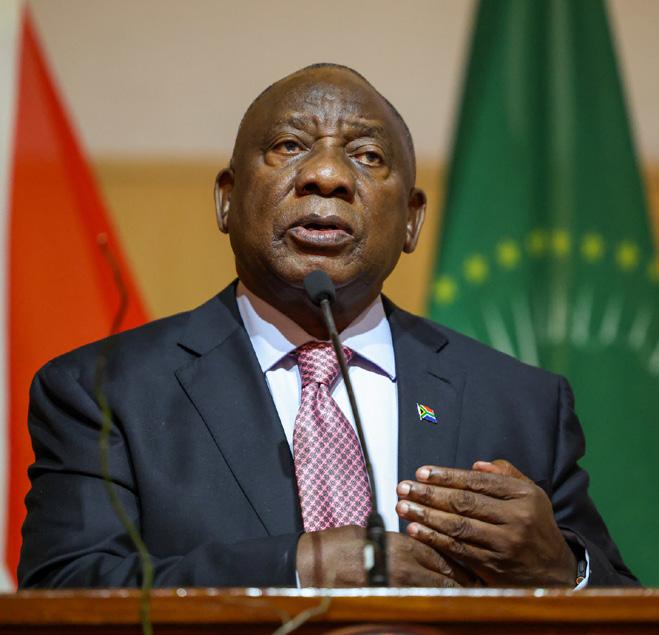
25 NOV - 10 DEC
The 16 Days of Activism for No Violence against Women and Children Campaign (16 Days Campaign) is a United Nations campaign which takes place annually from 25 November (International Day of No Violence against Women) to 10 December (International Human Rights Day).
Given the scourge of GenderBased violence in the country, government is implementing the Emergency Response Action Plan on Gender-Based Violence and Femicide, which was announced by President Cyril in September 2019.
The 16 Days Campaign forms the centre point of government’s comprehensive 365 Days of Activism for No Violence Against Women and Children.
During the 16 Days period, Government together with civil society and the private sector will host a series of community and sector dialogues and activities to foster a collaborative effort in dealing with GBVF.





